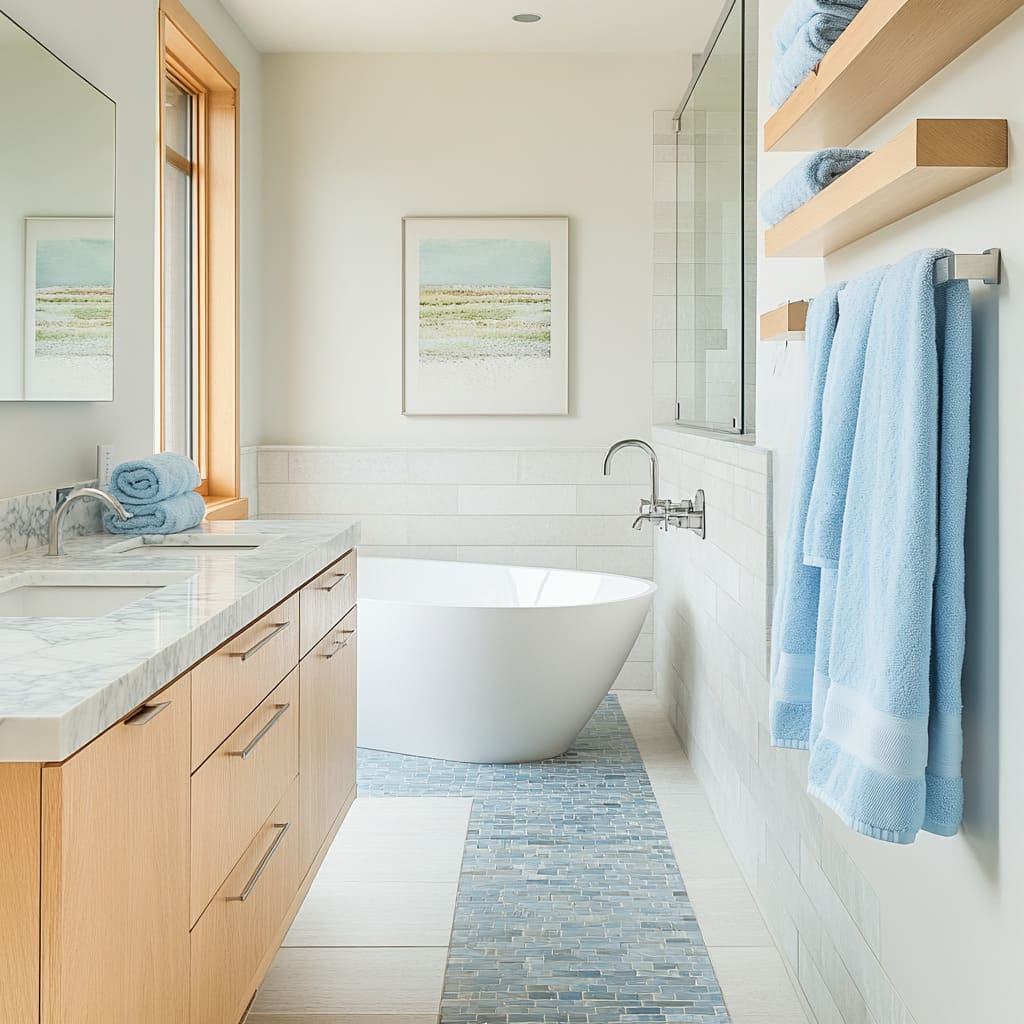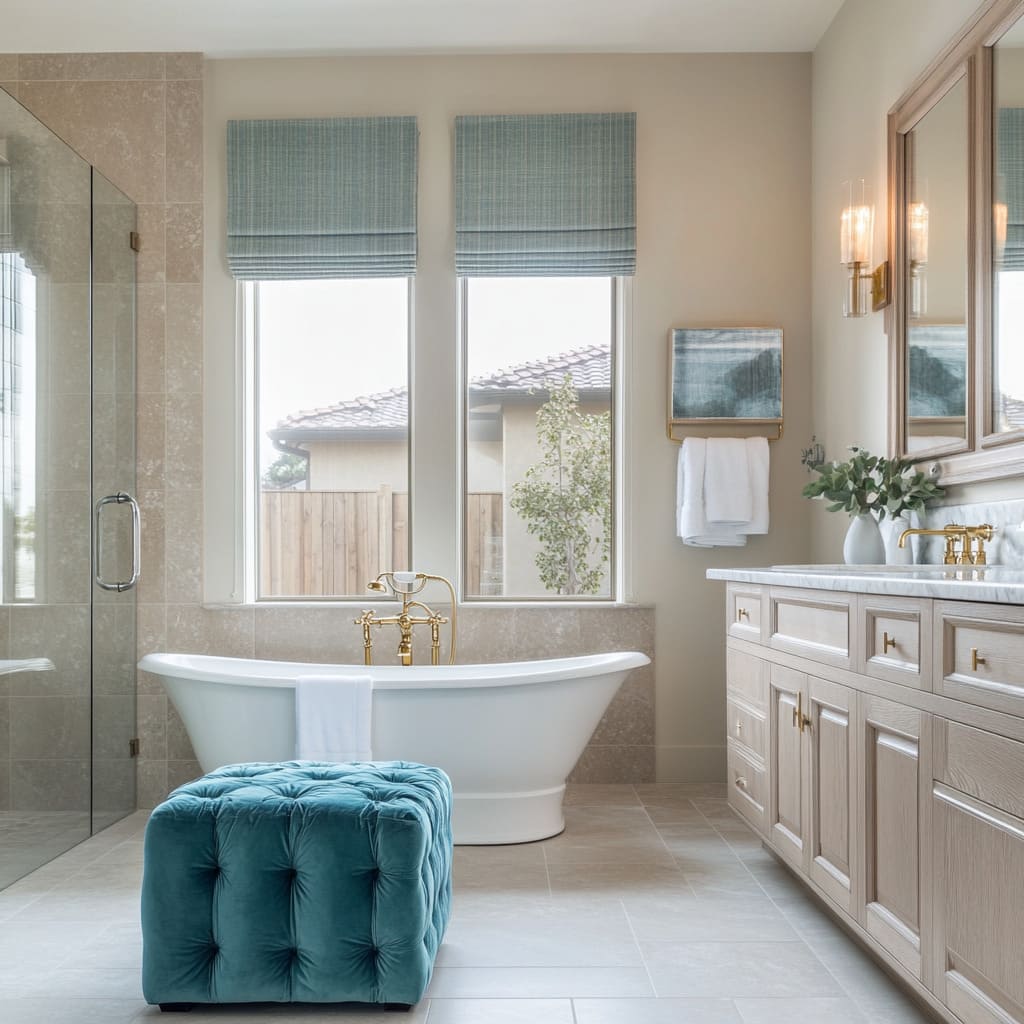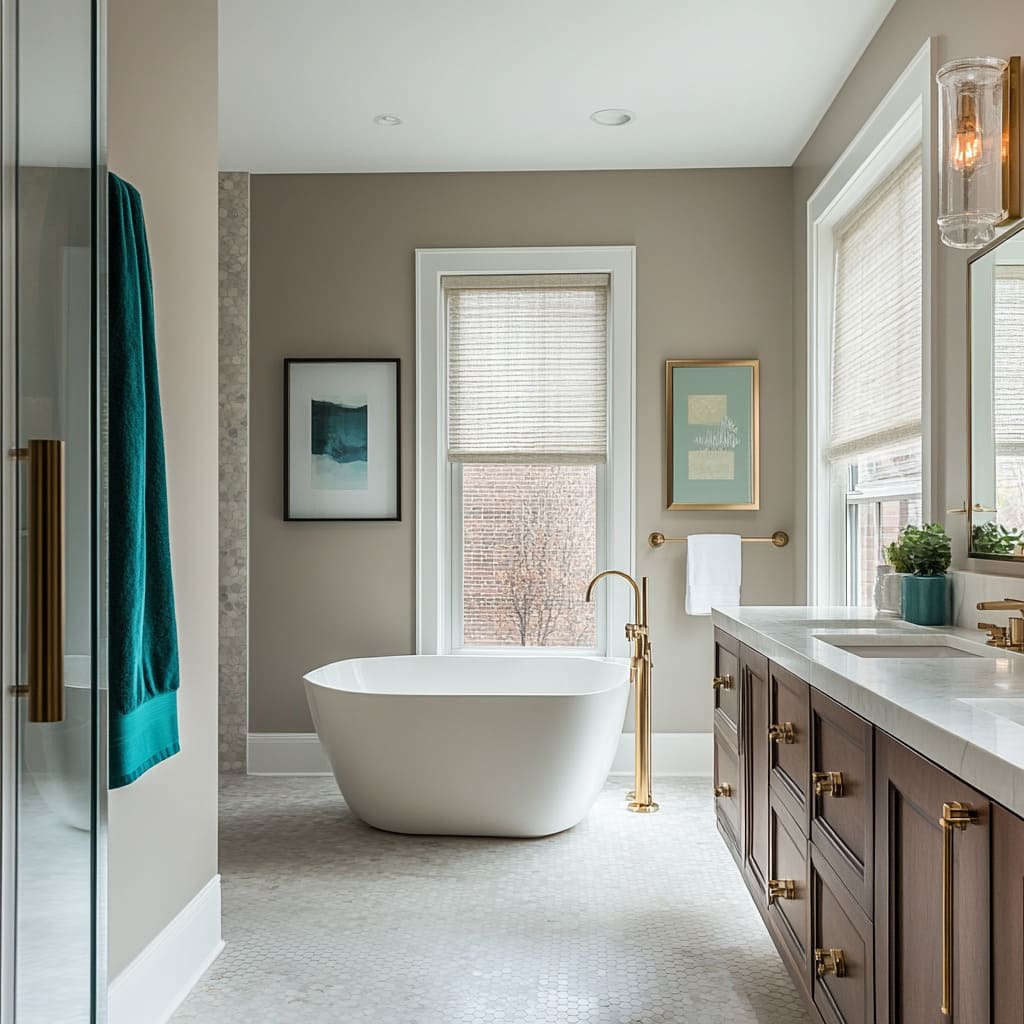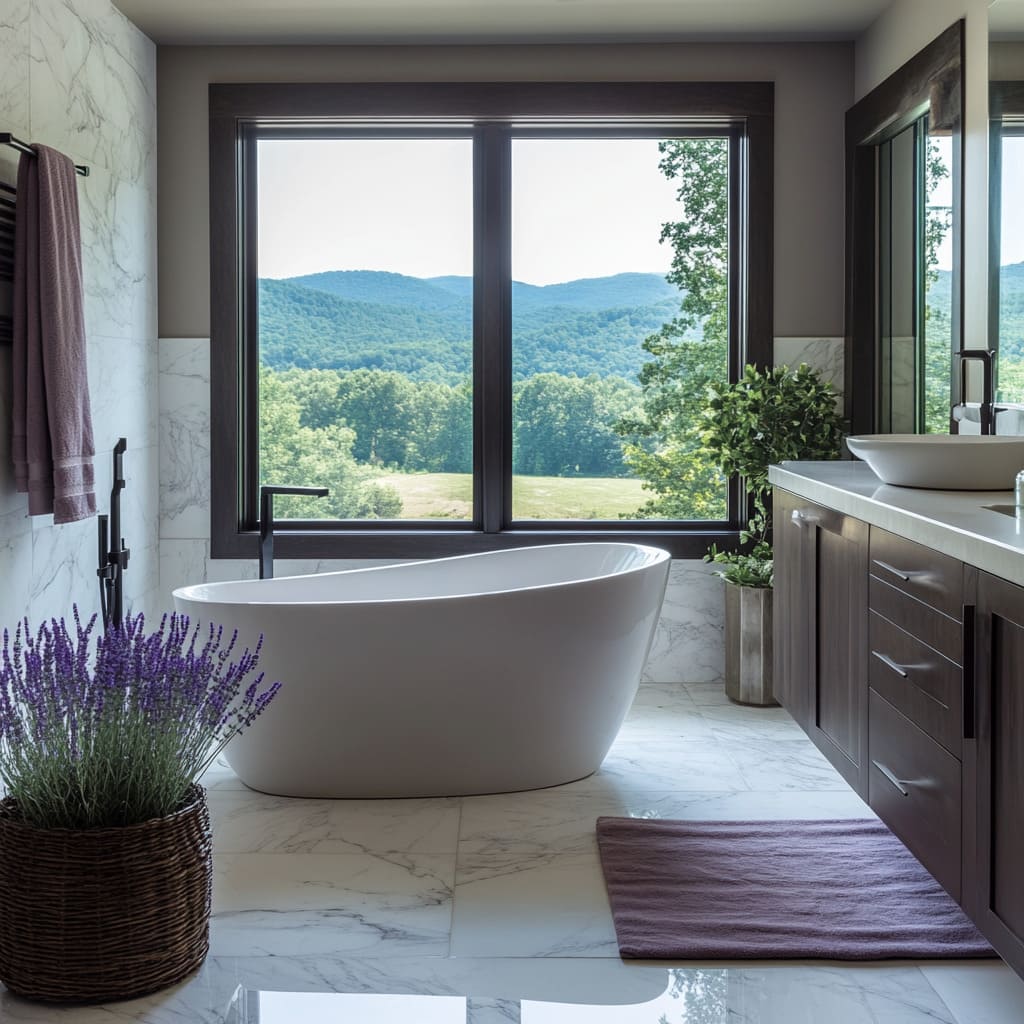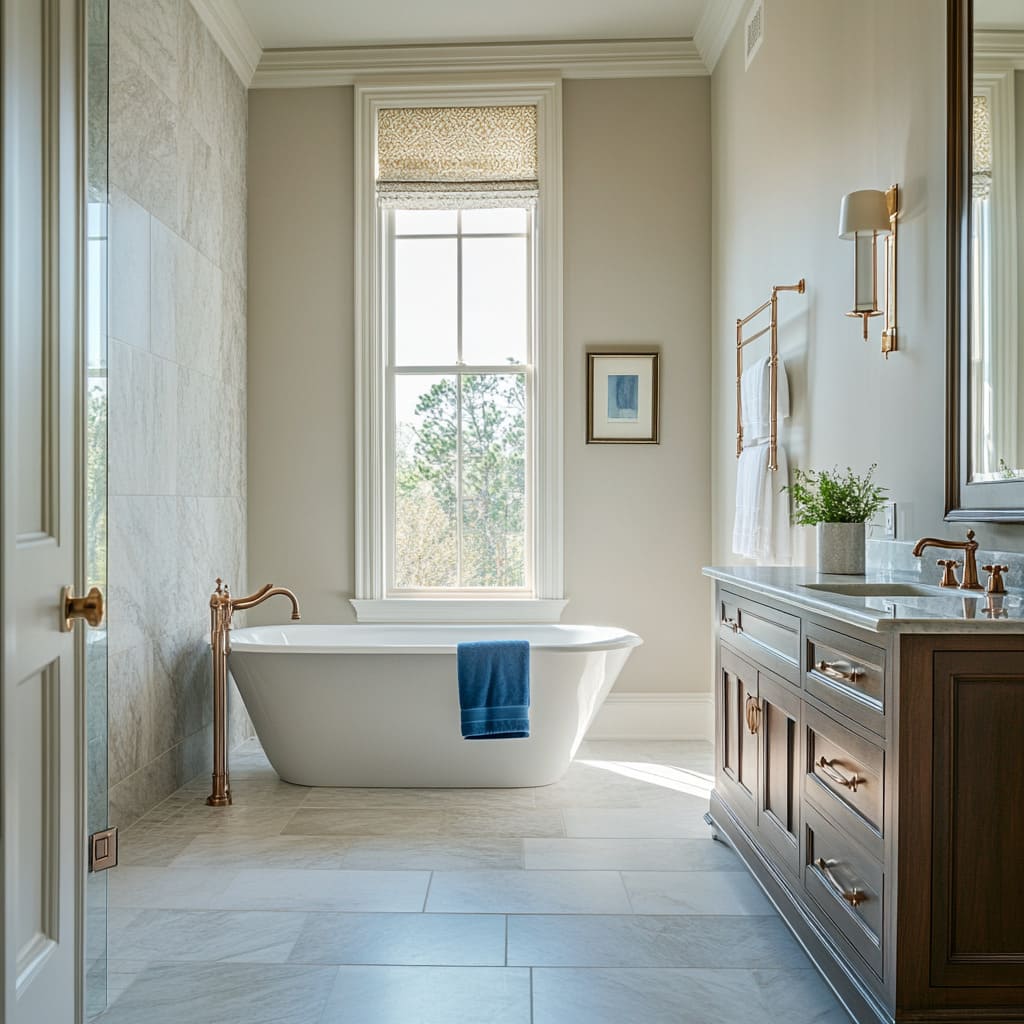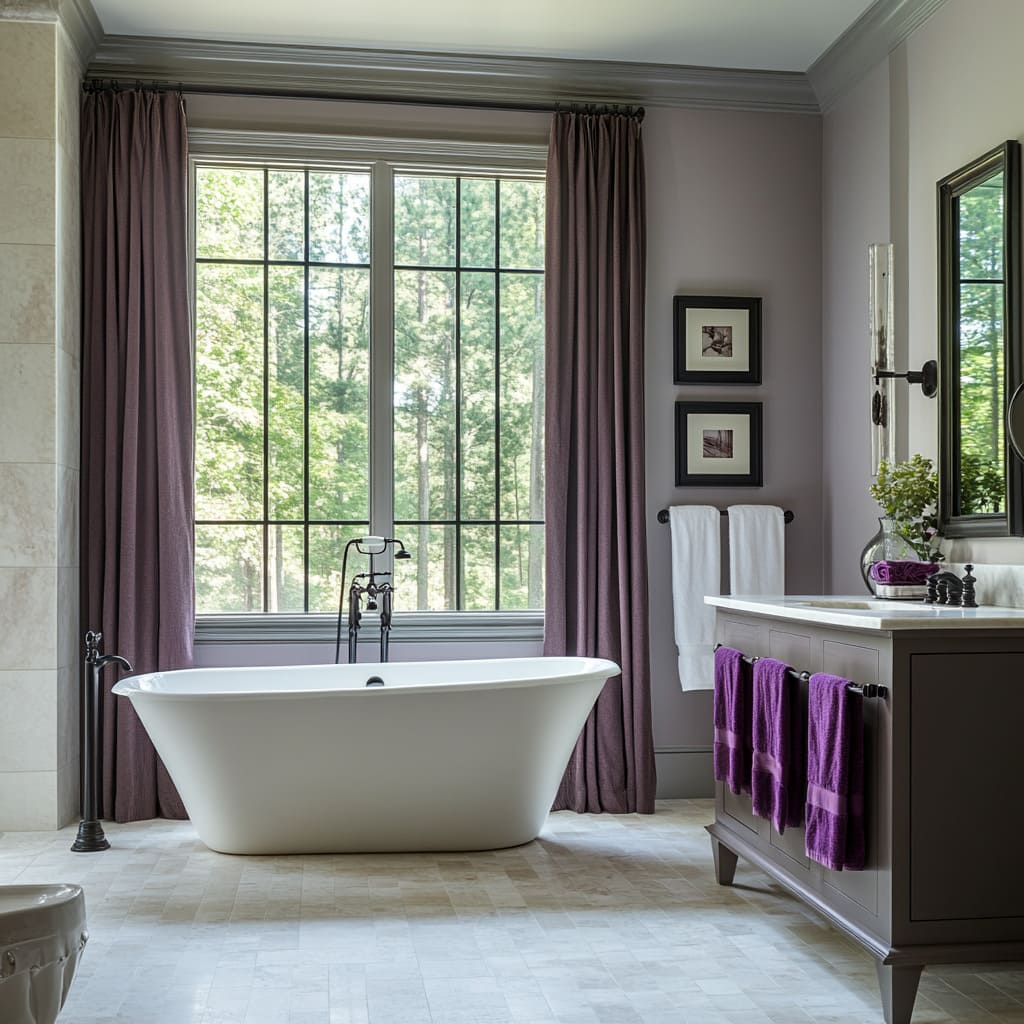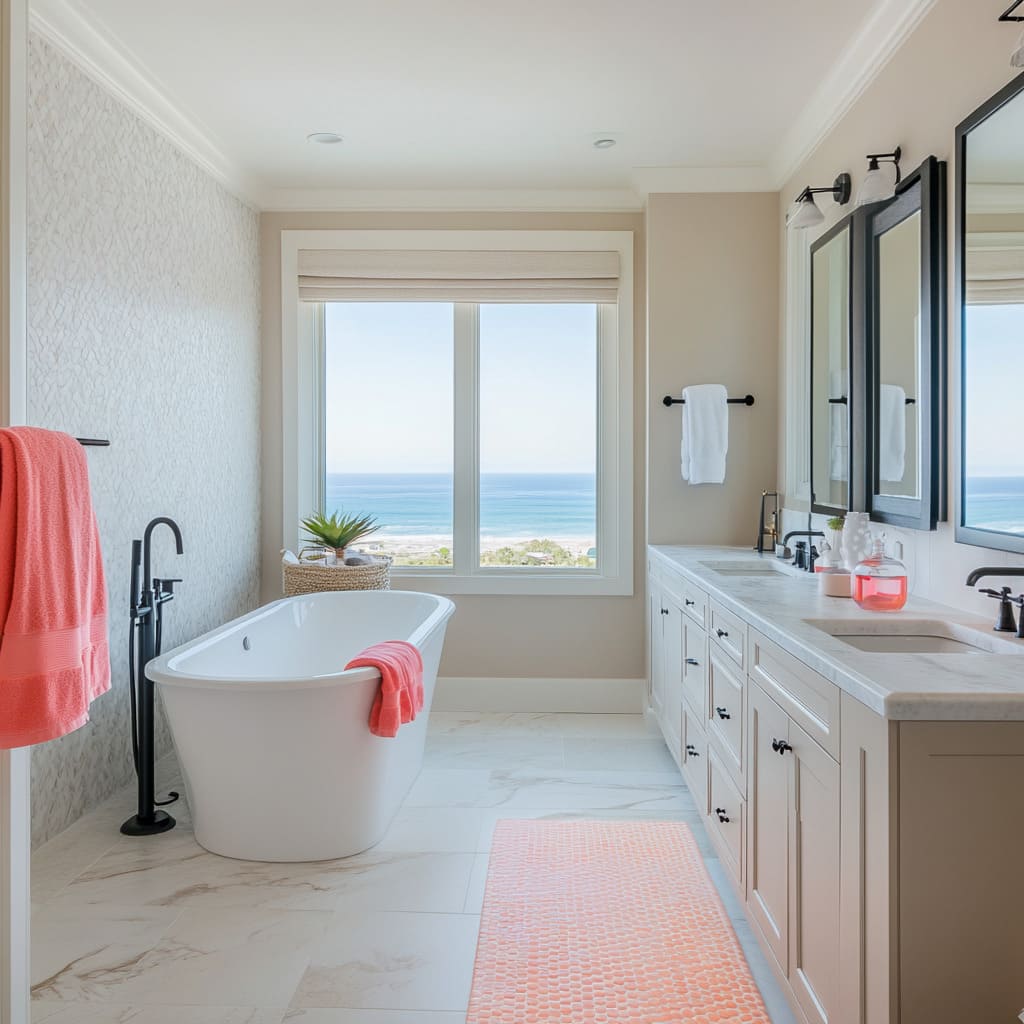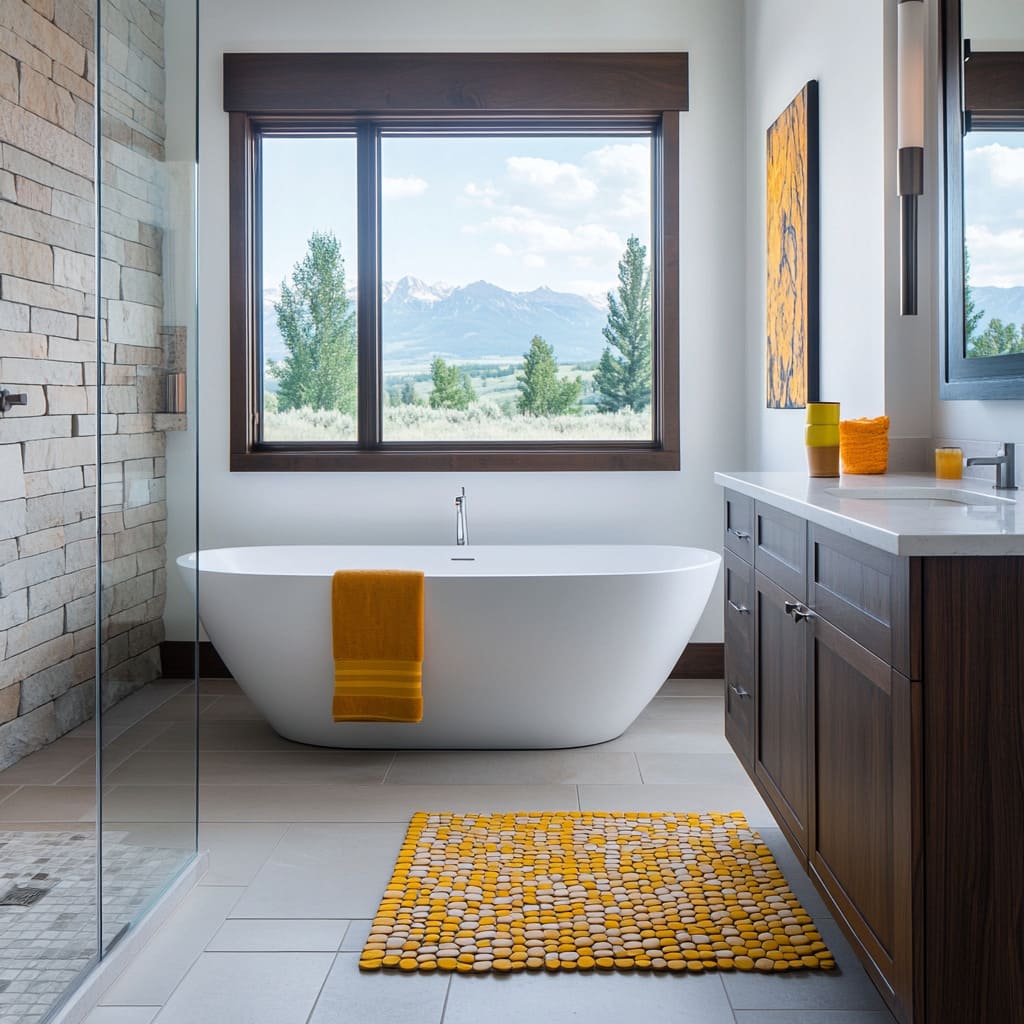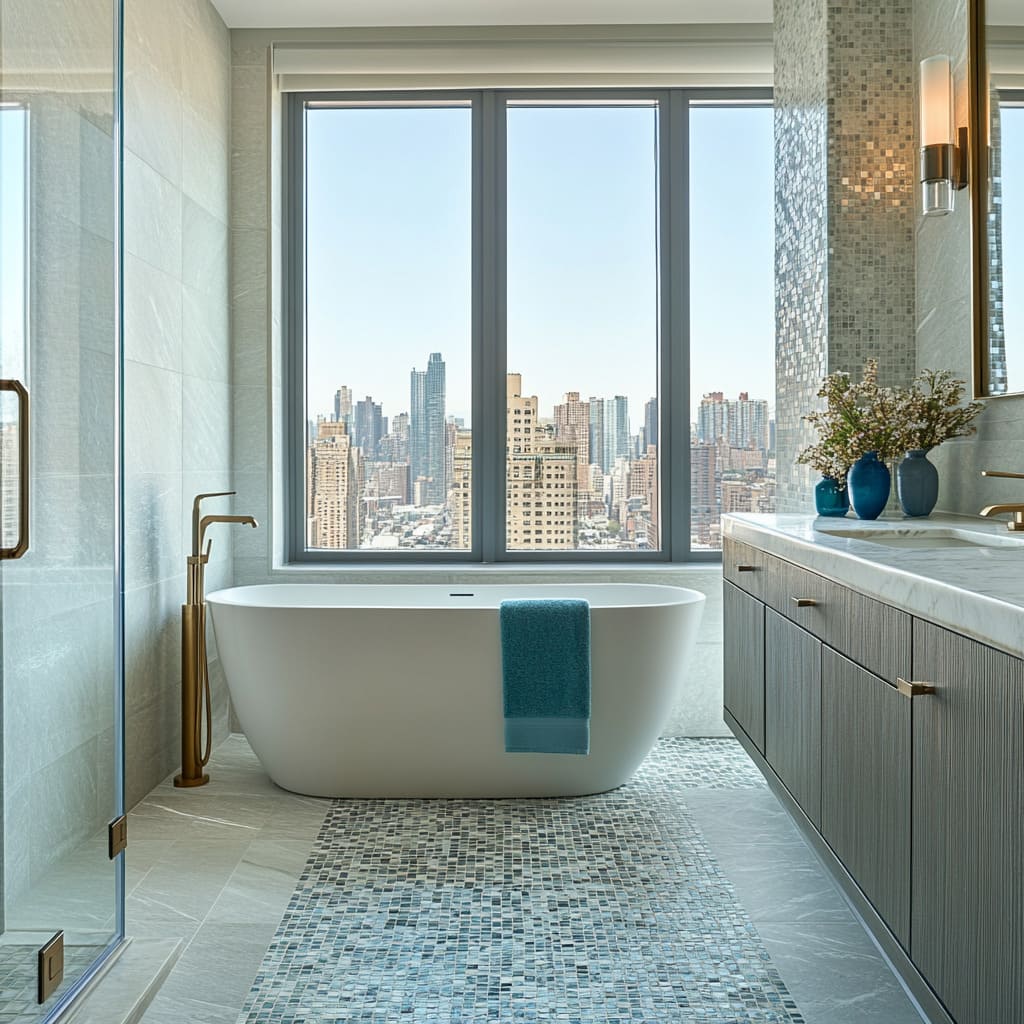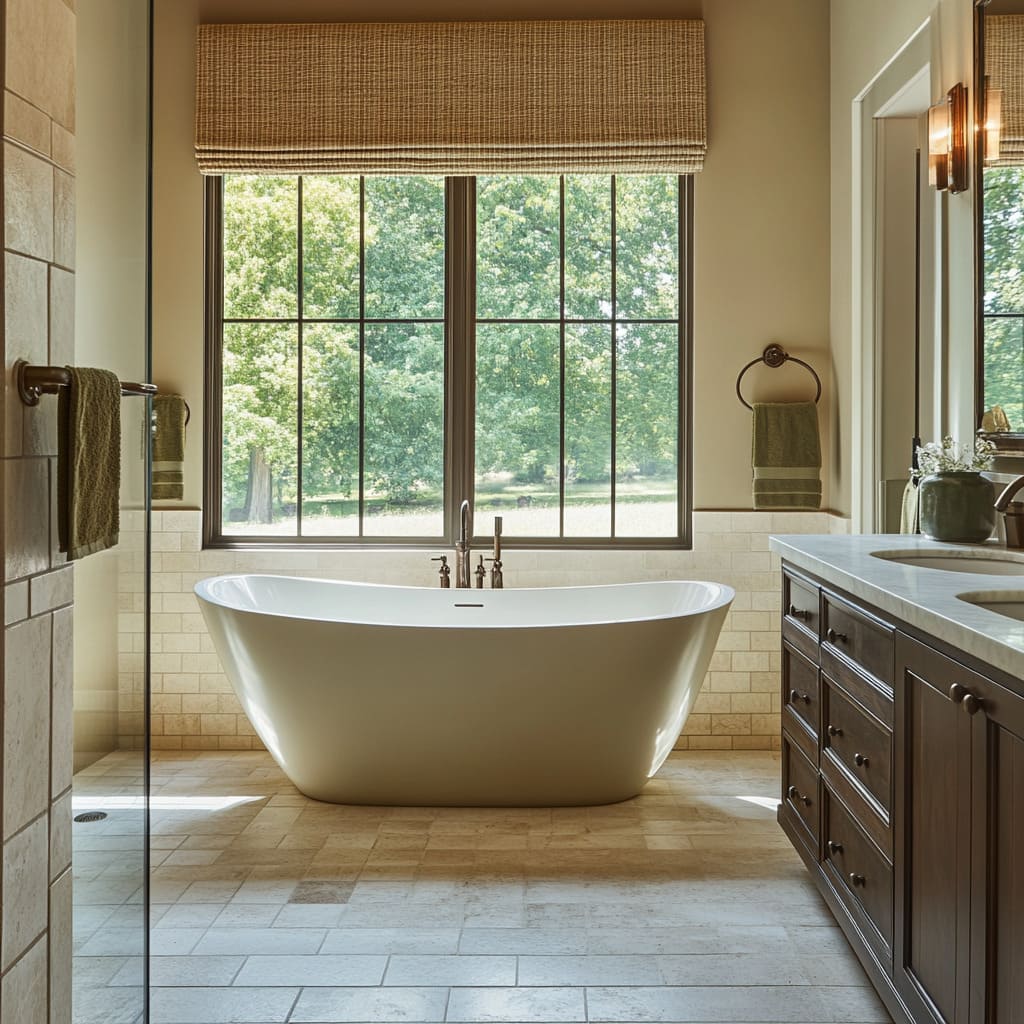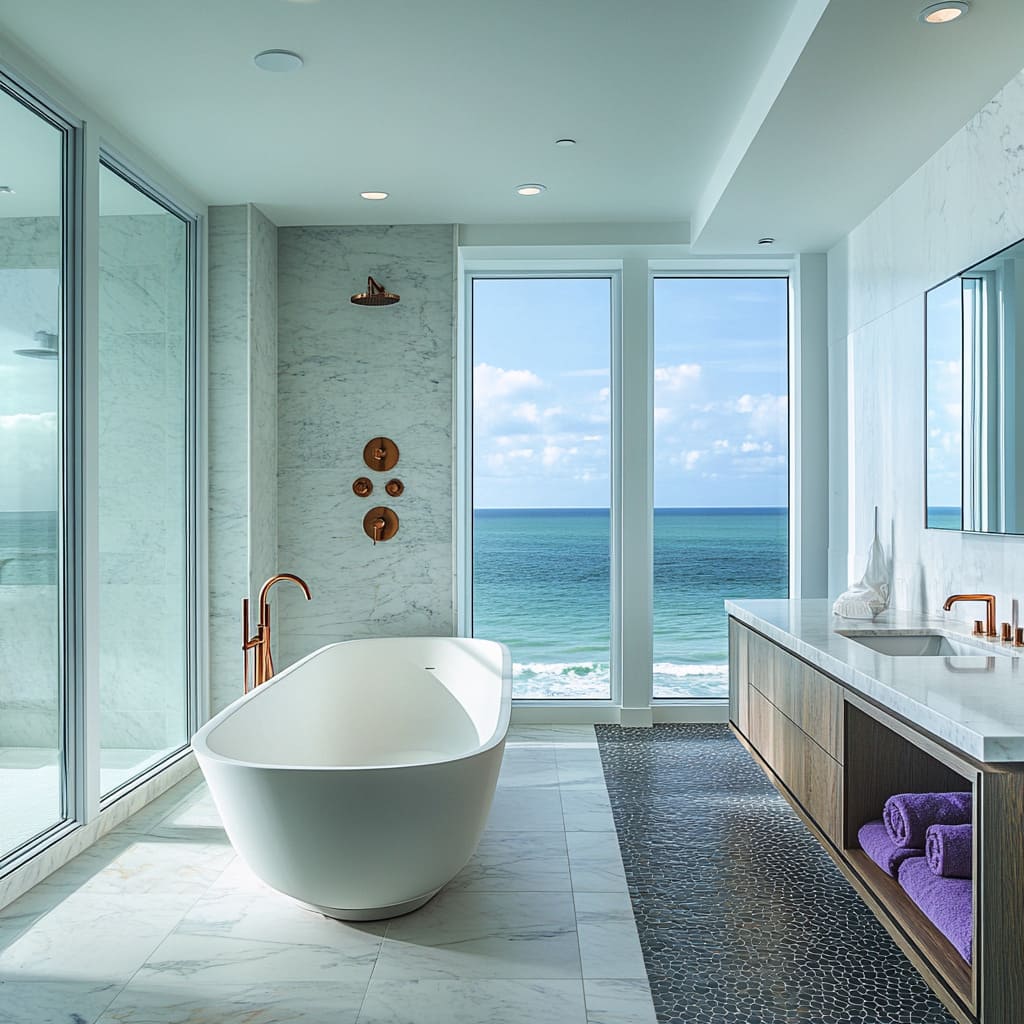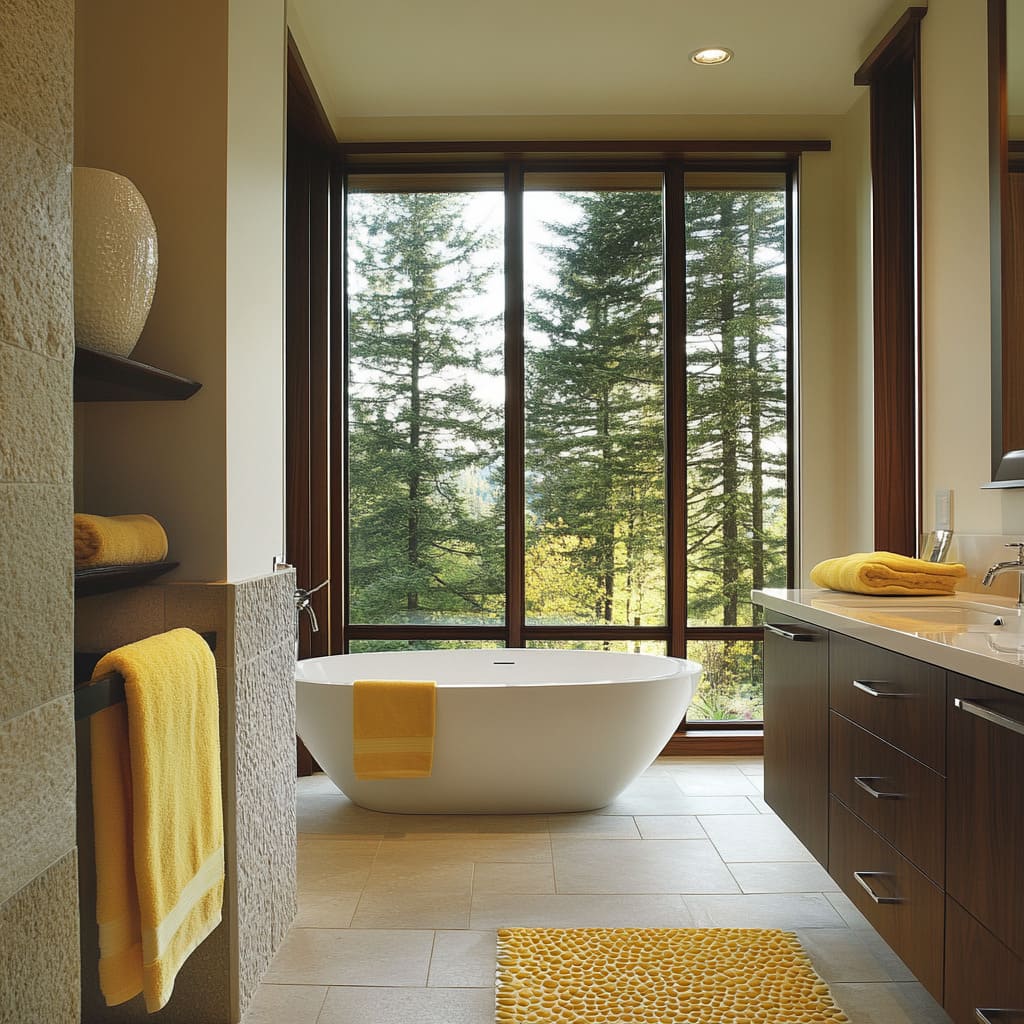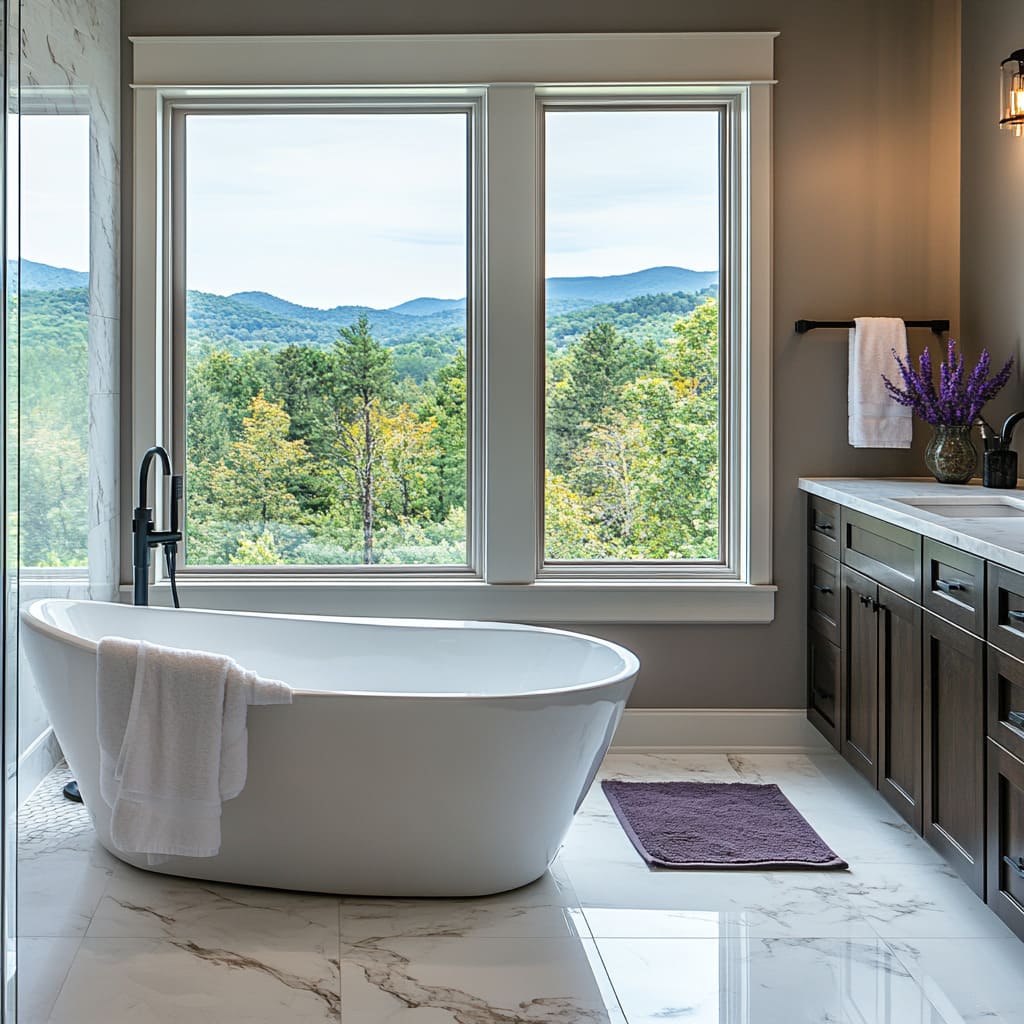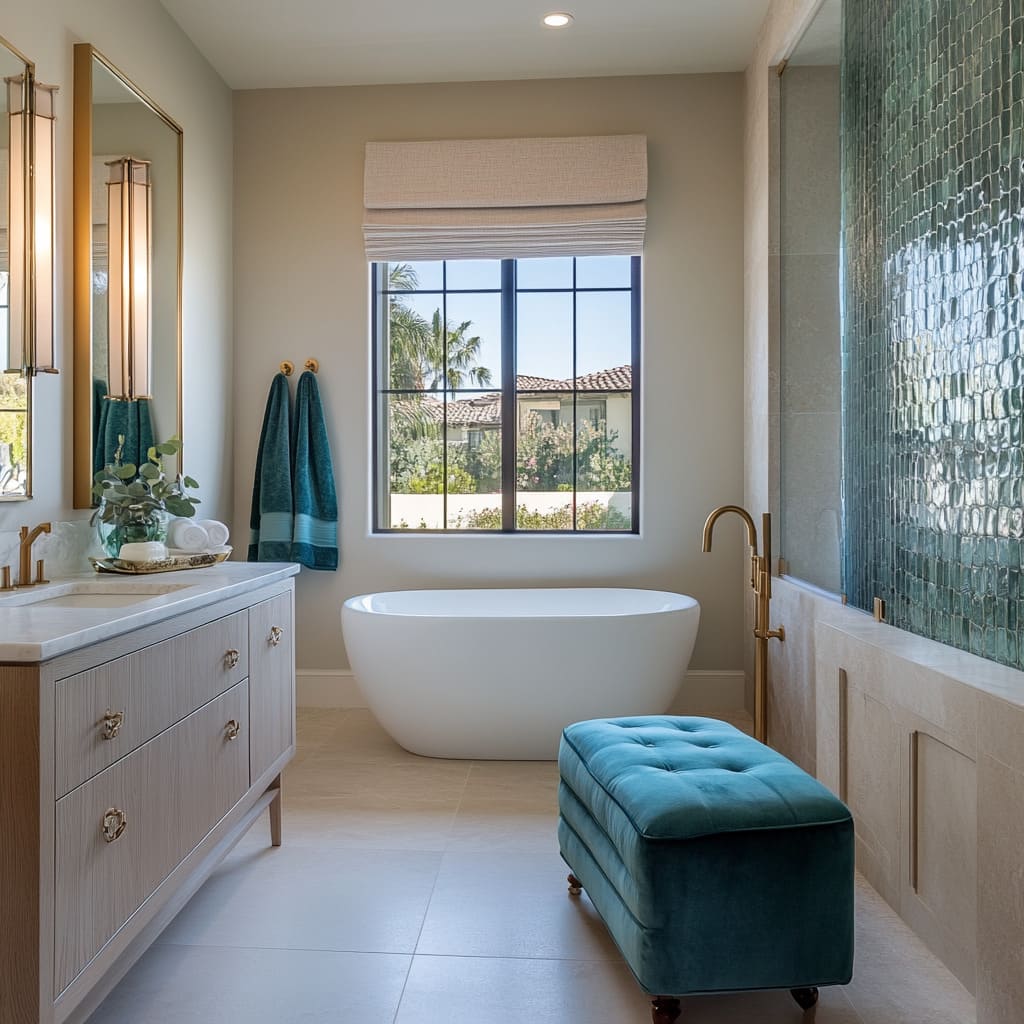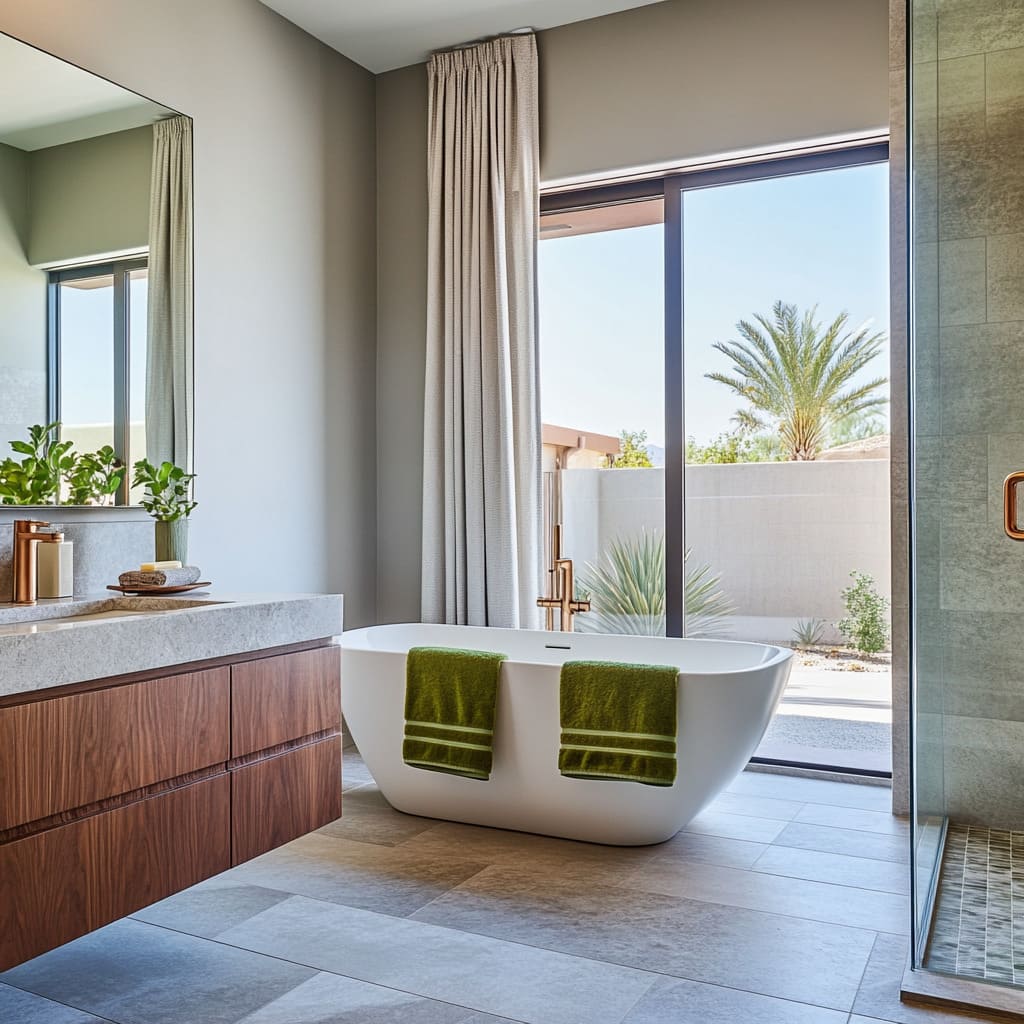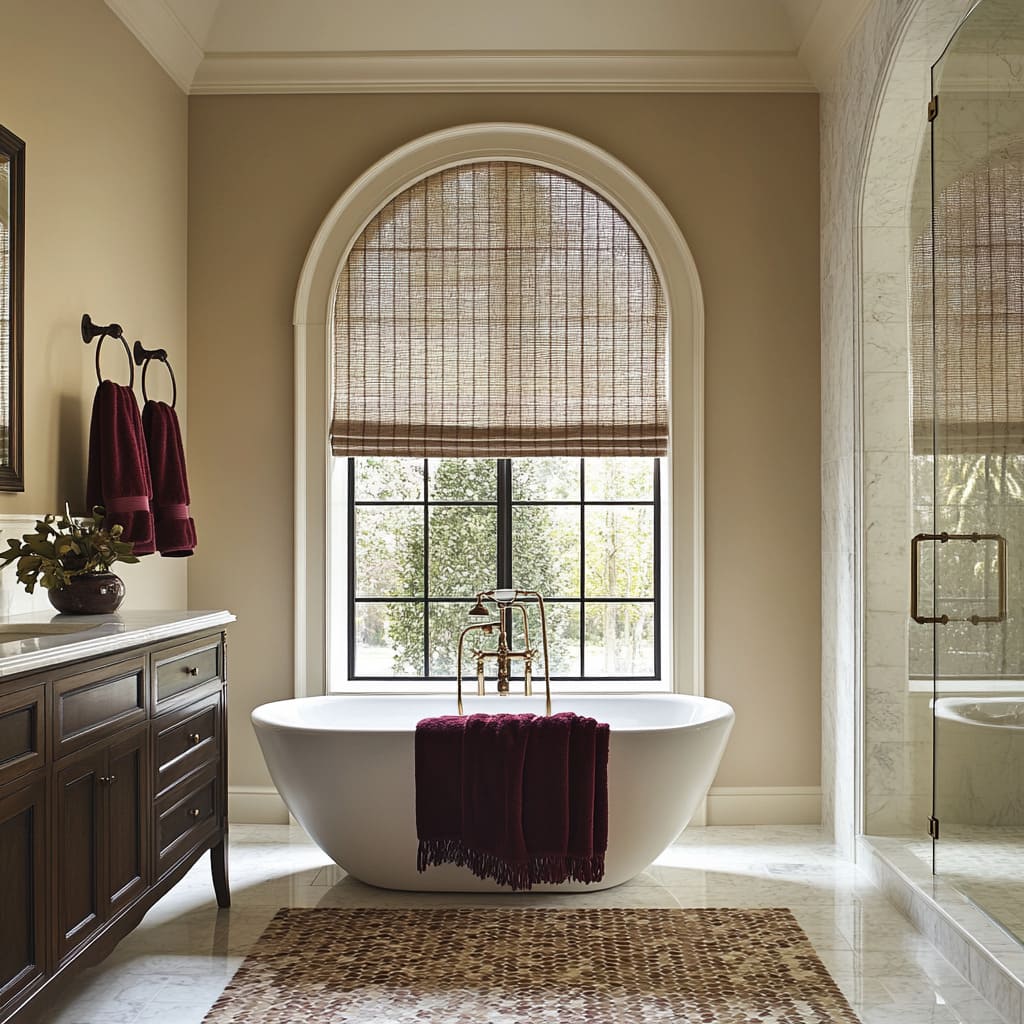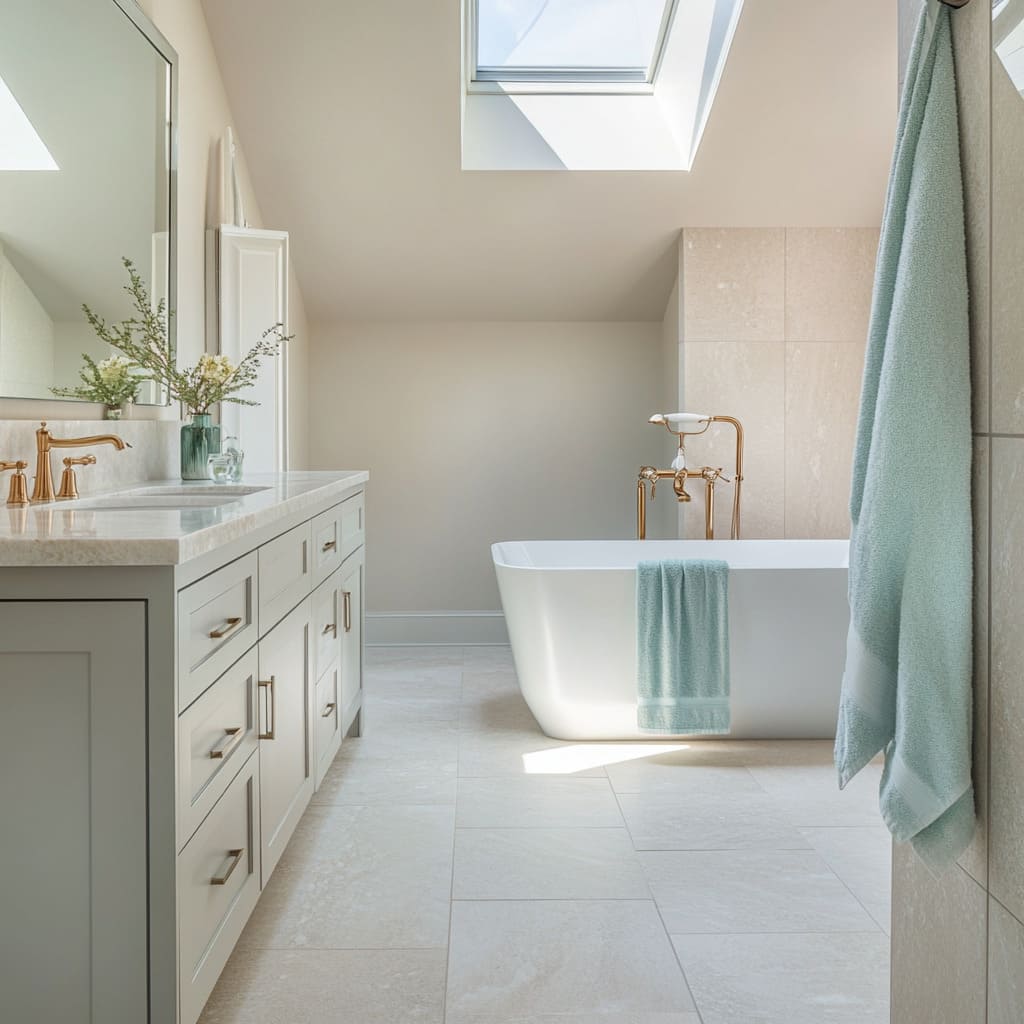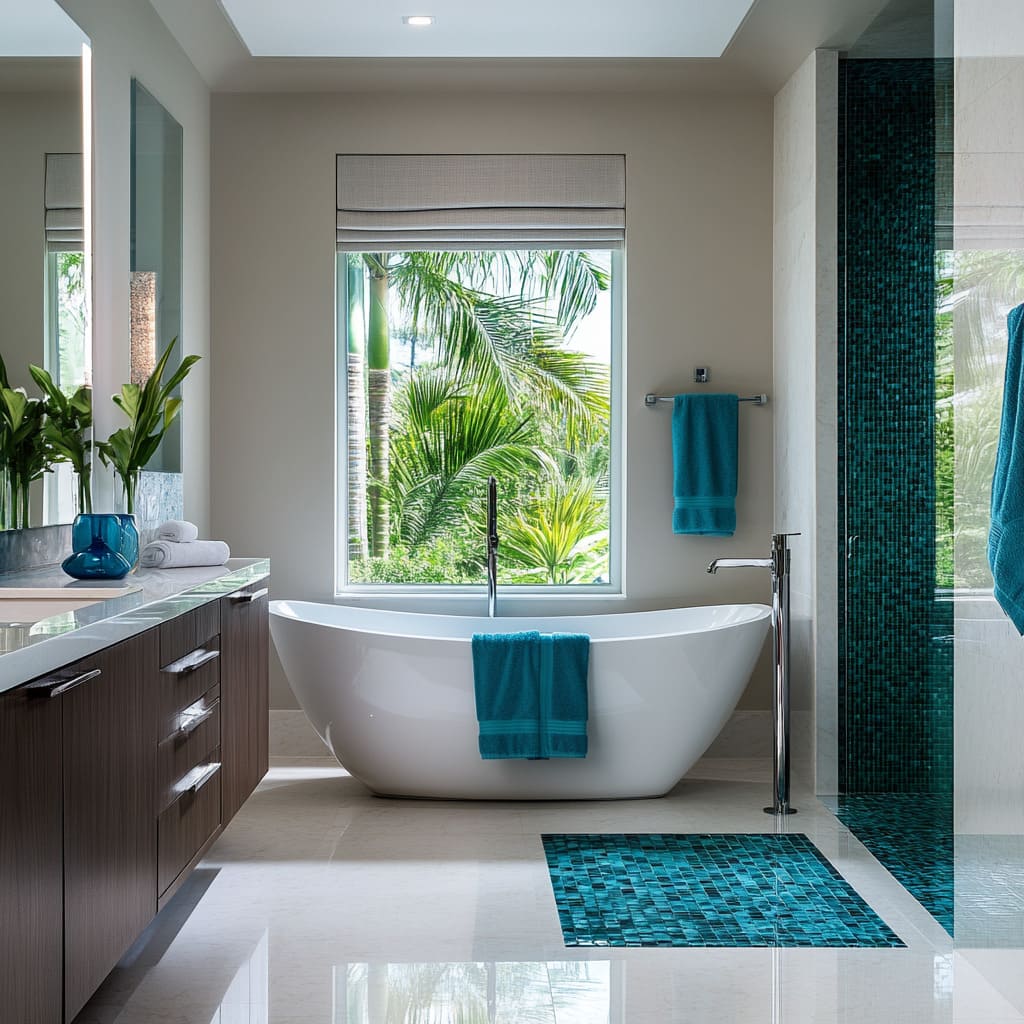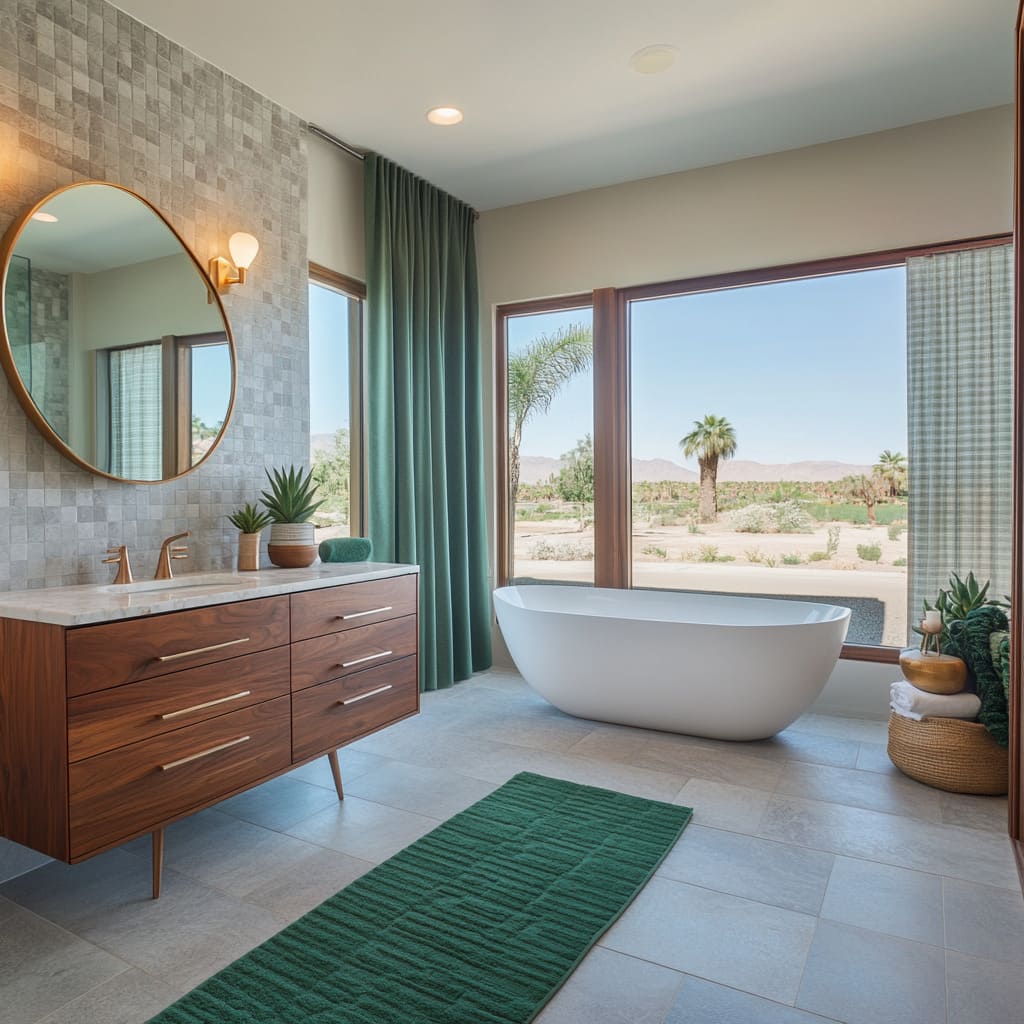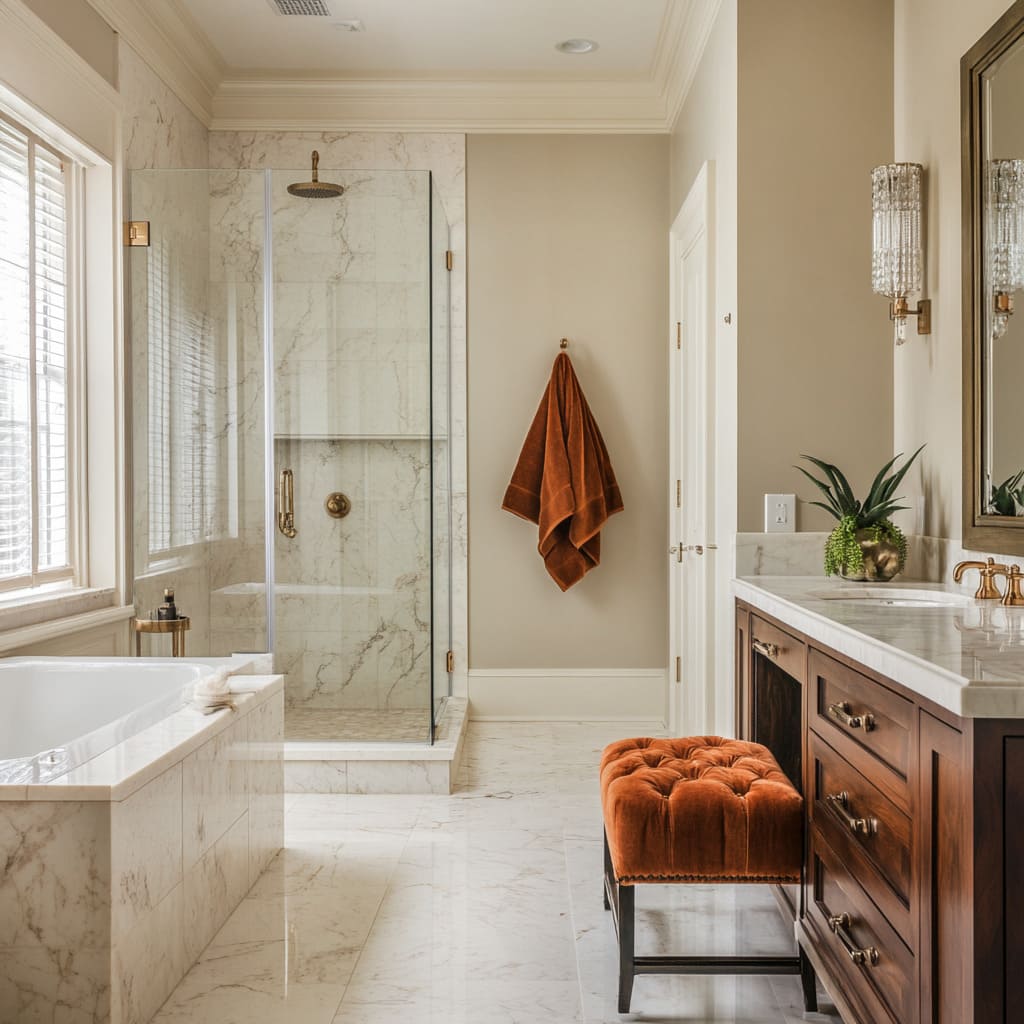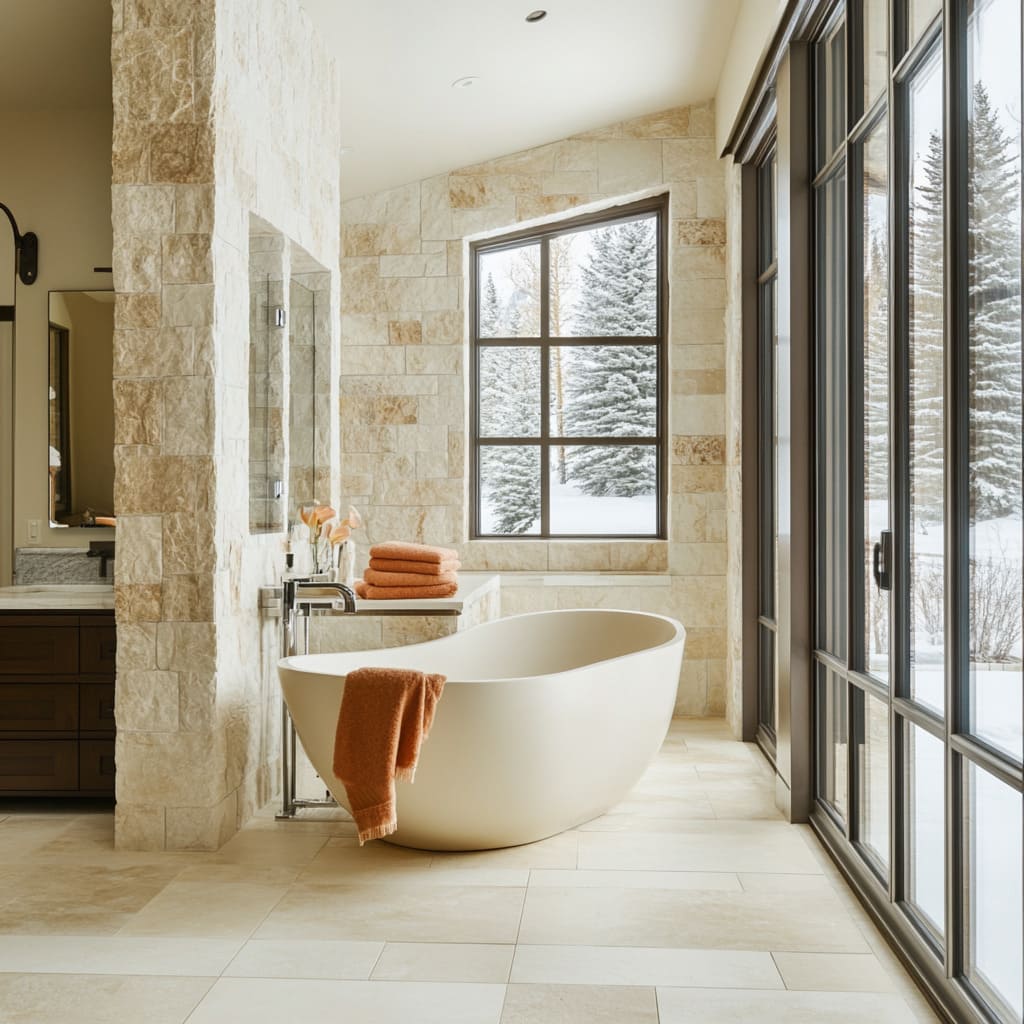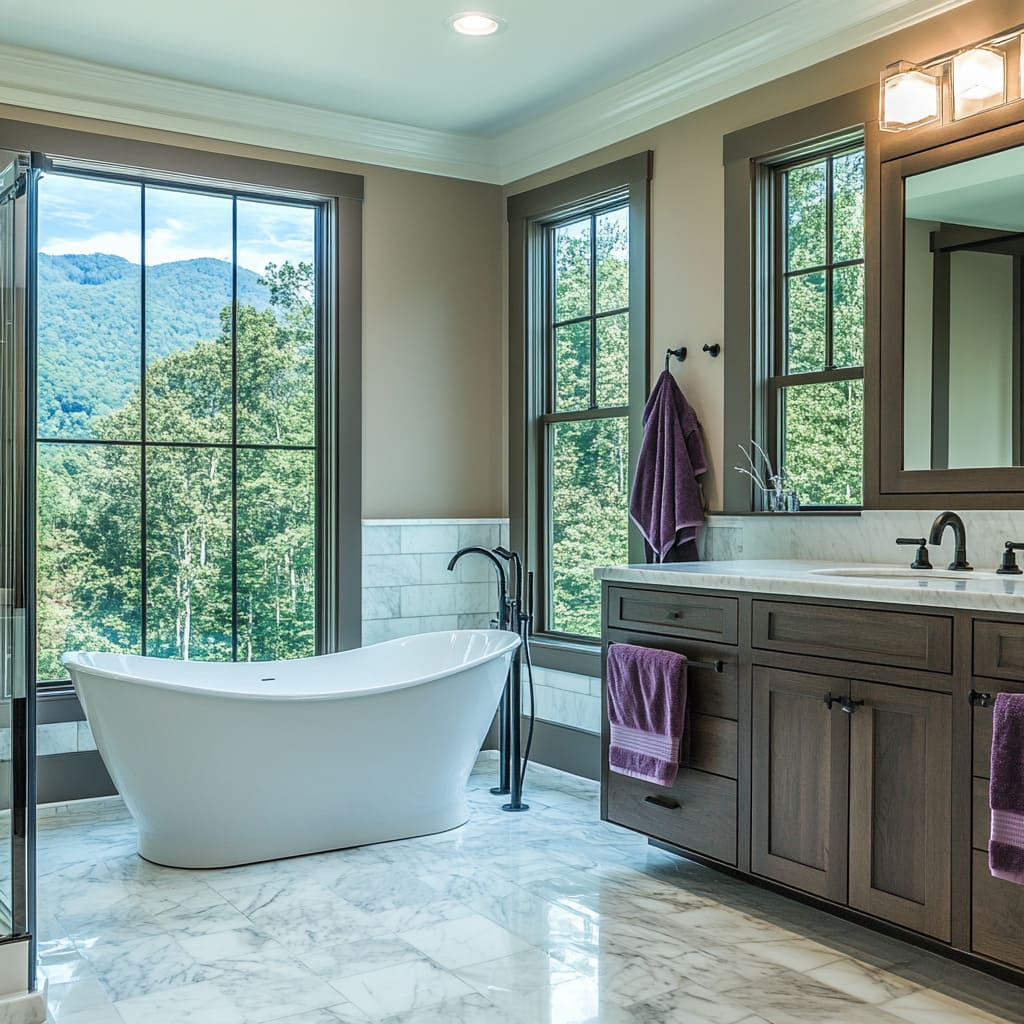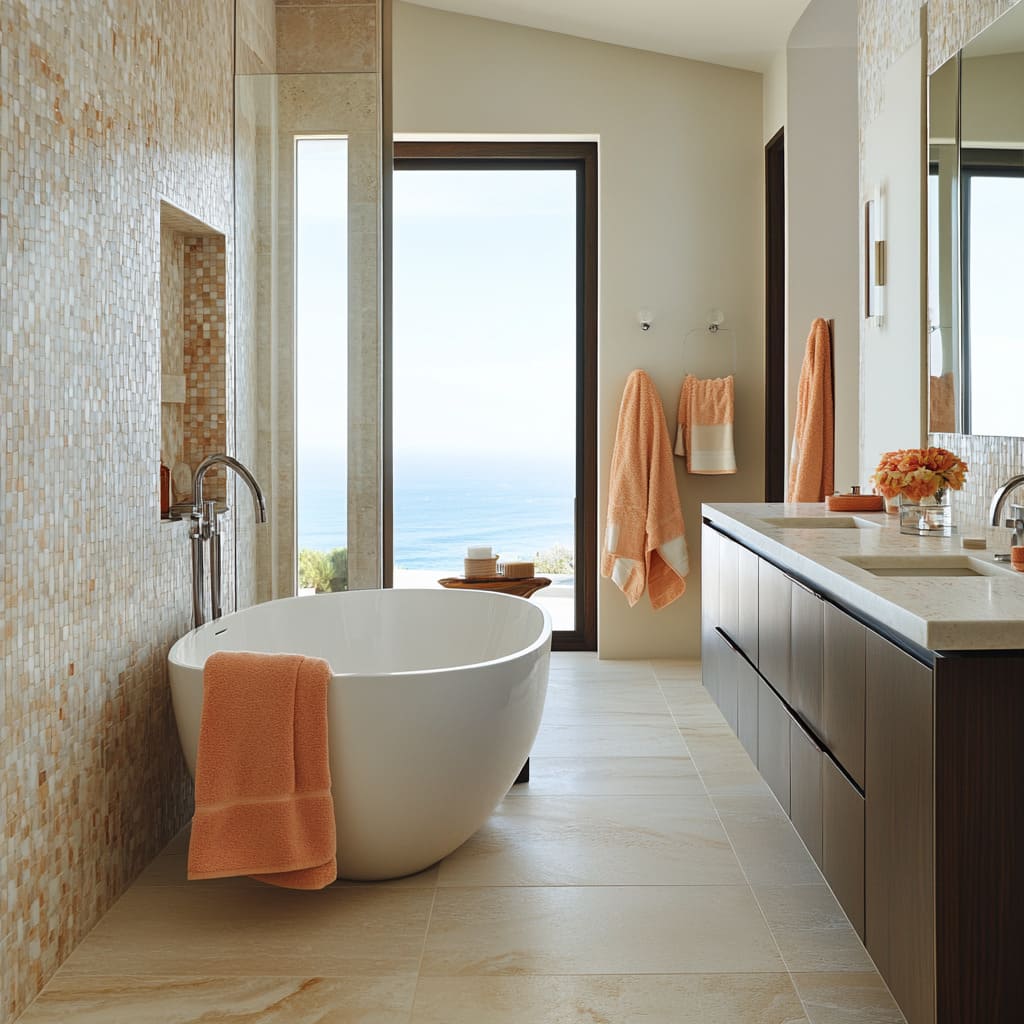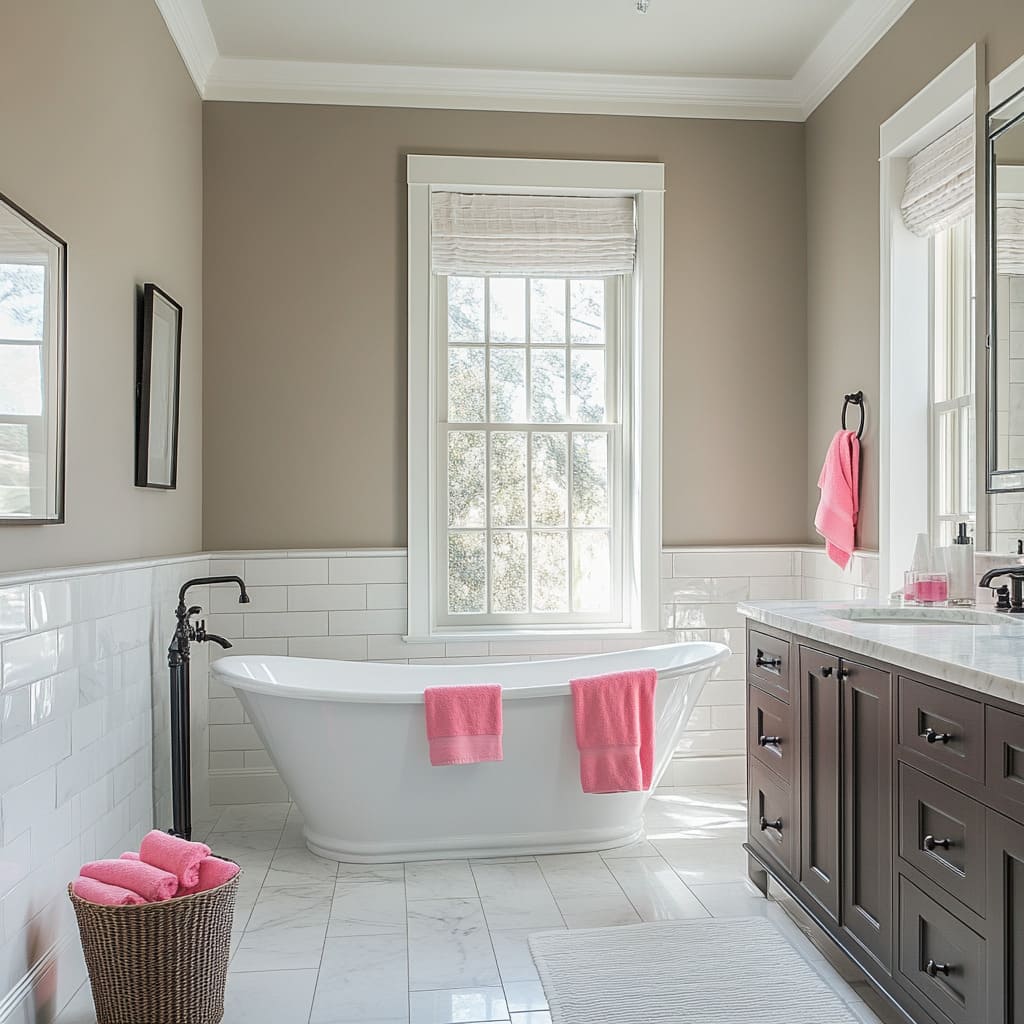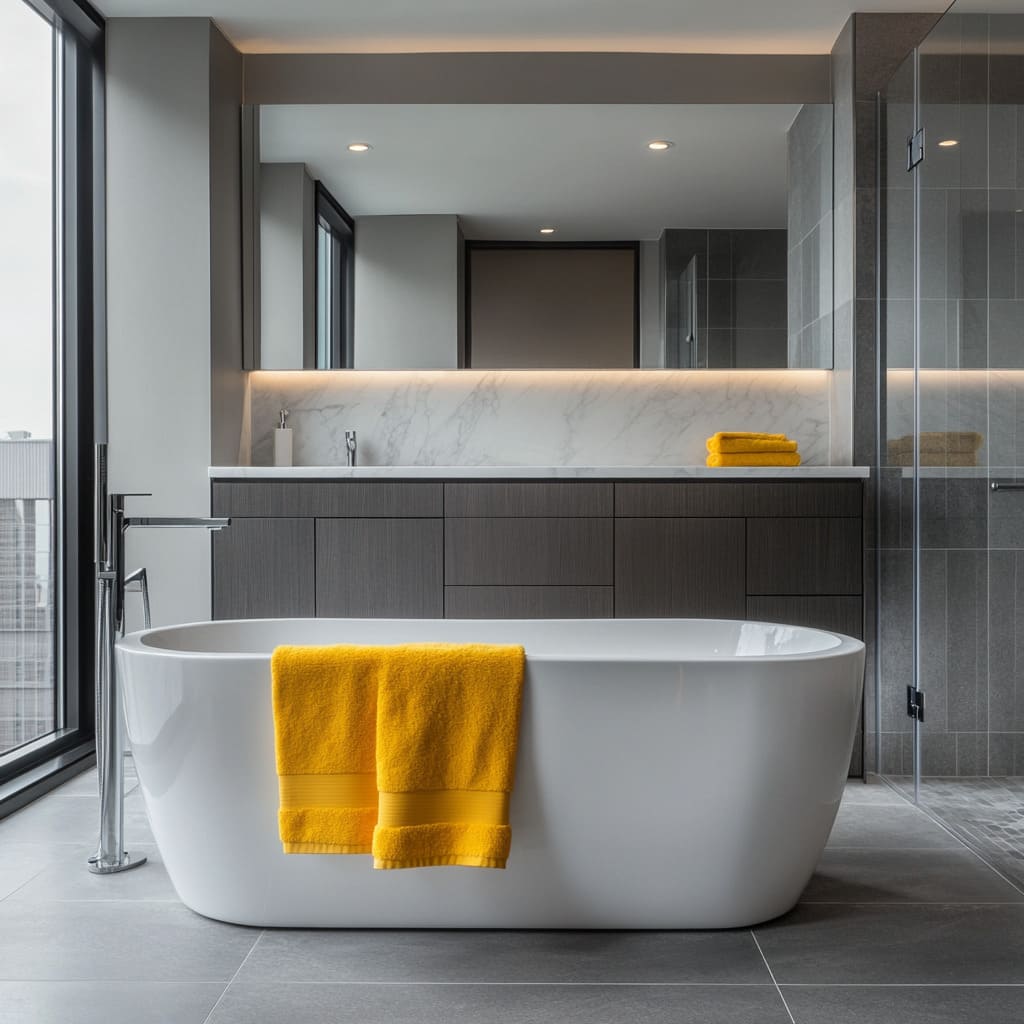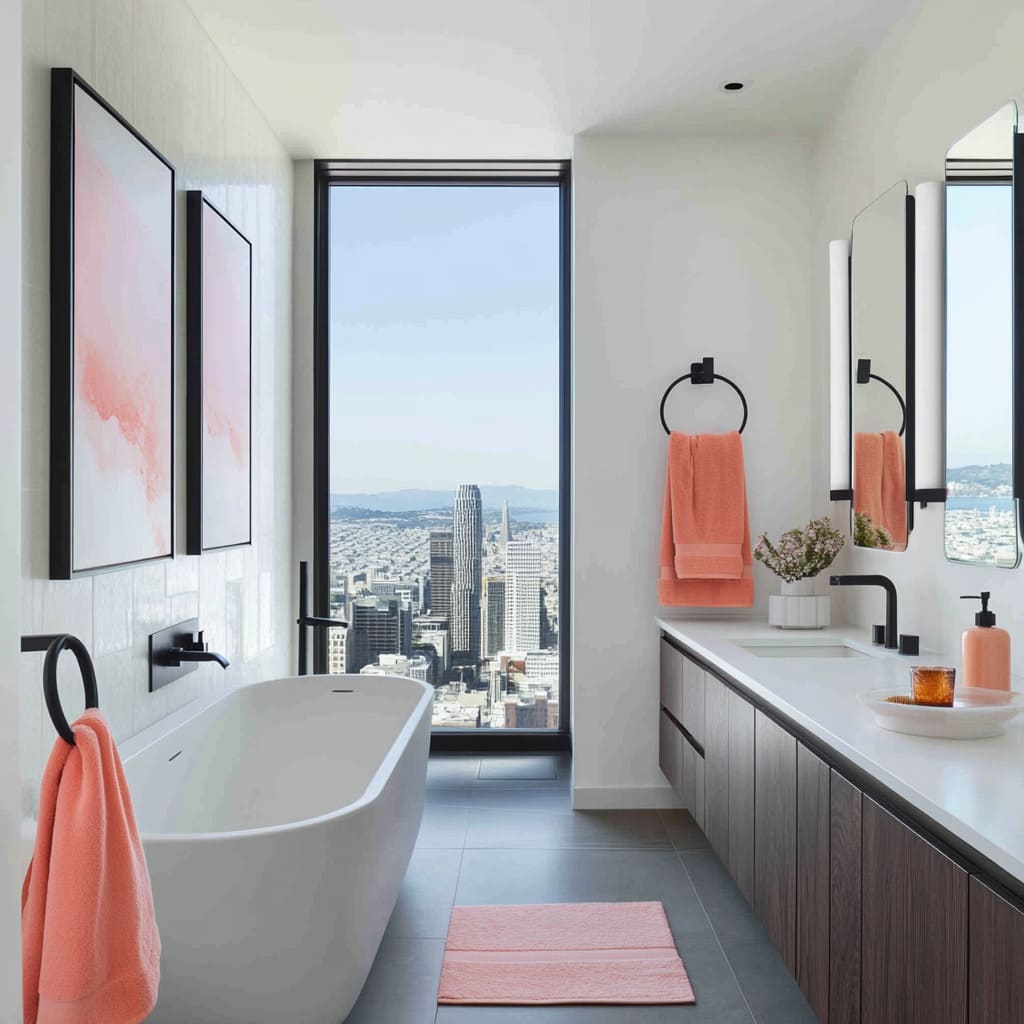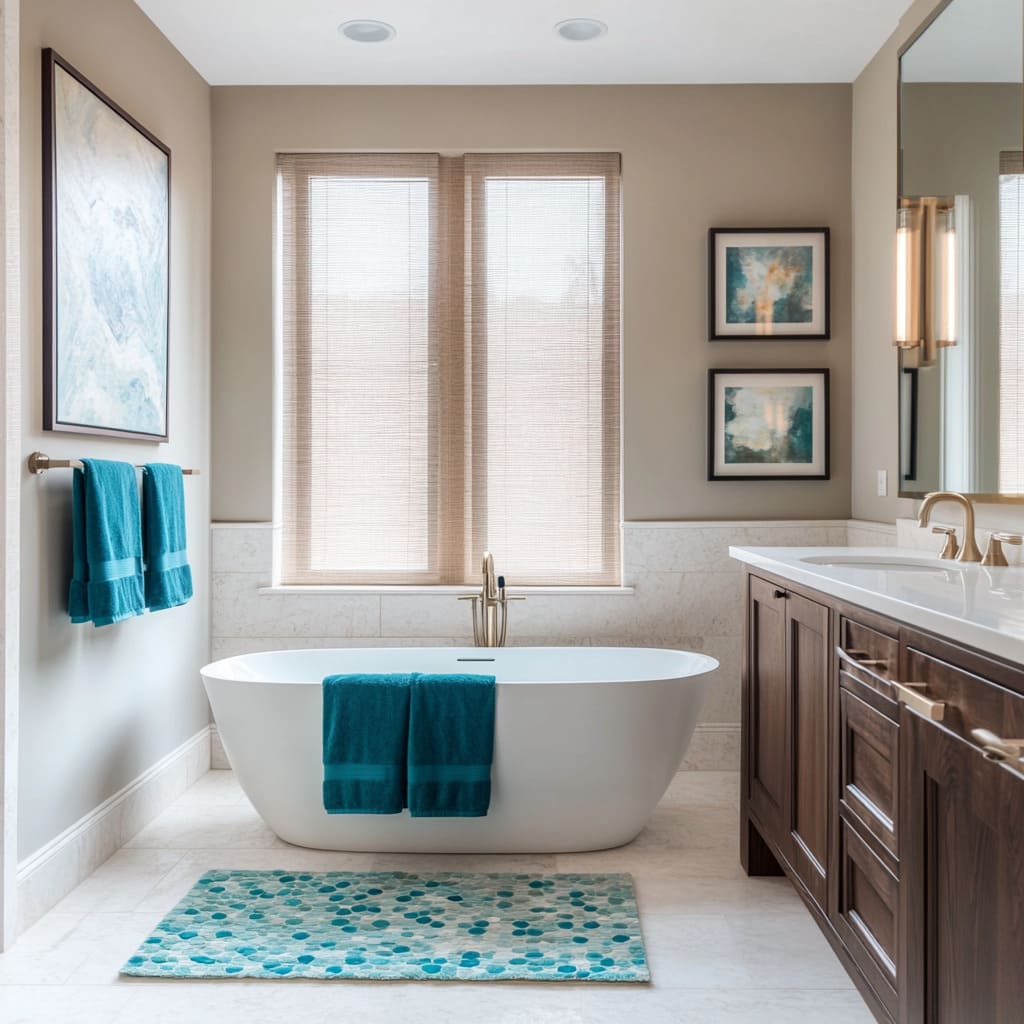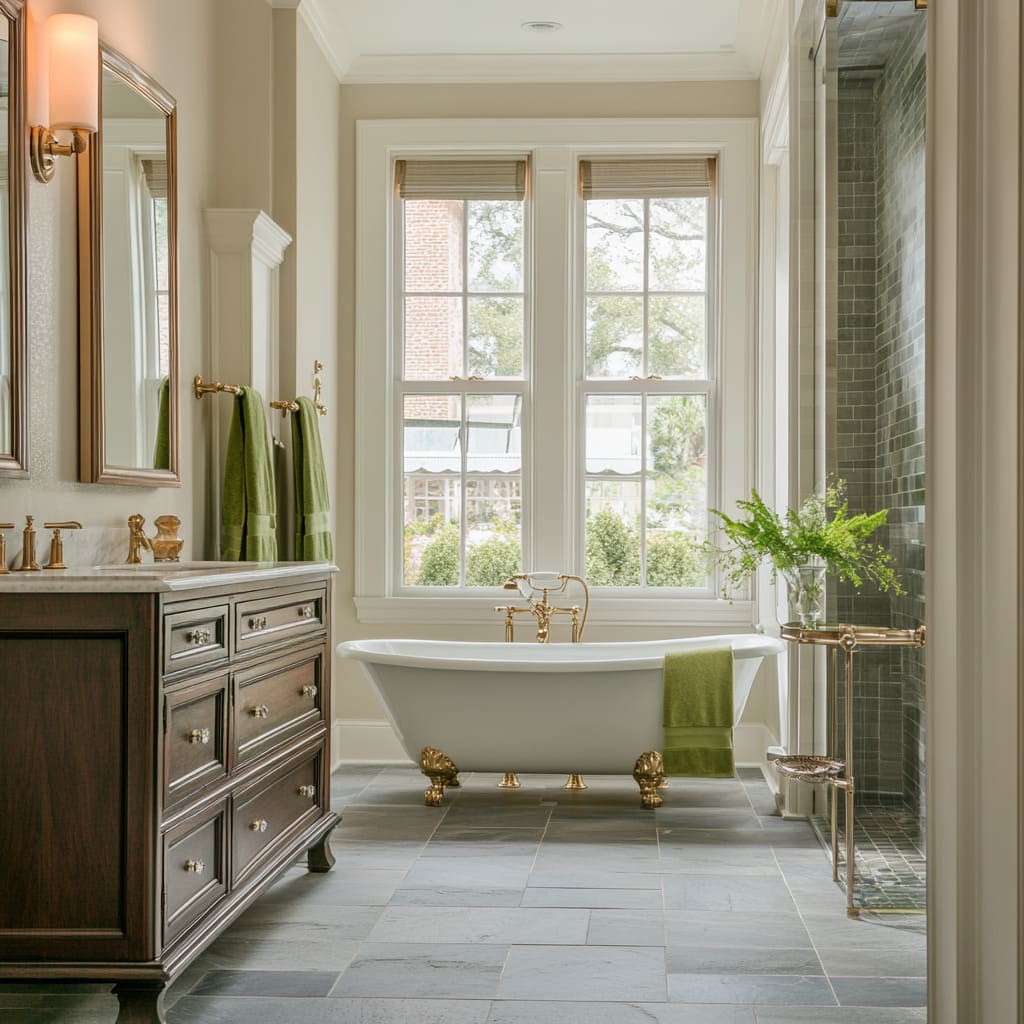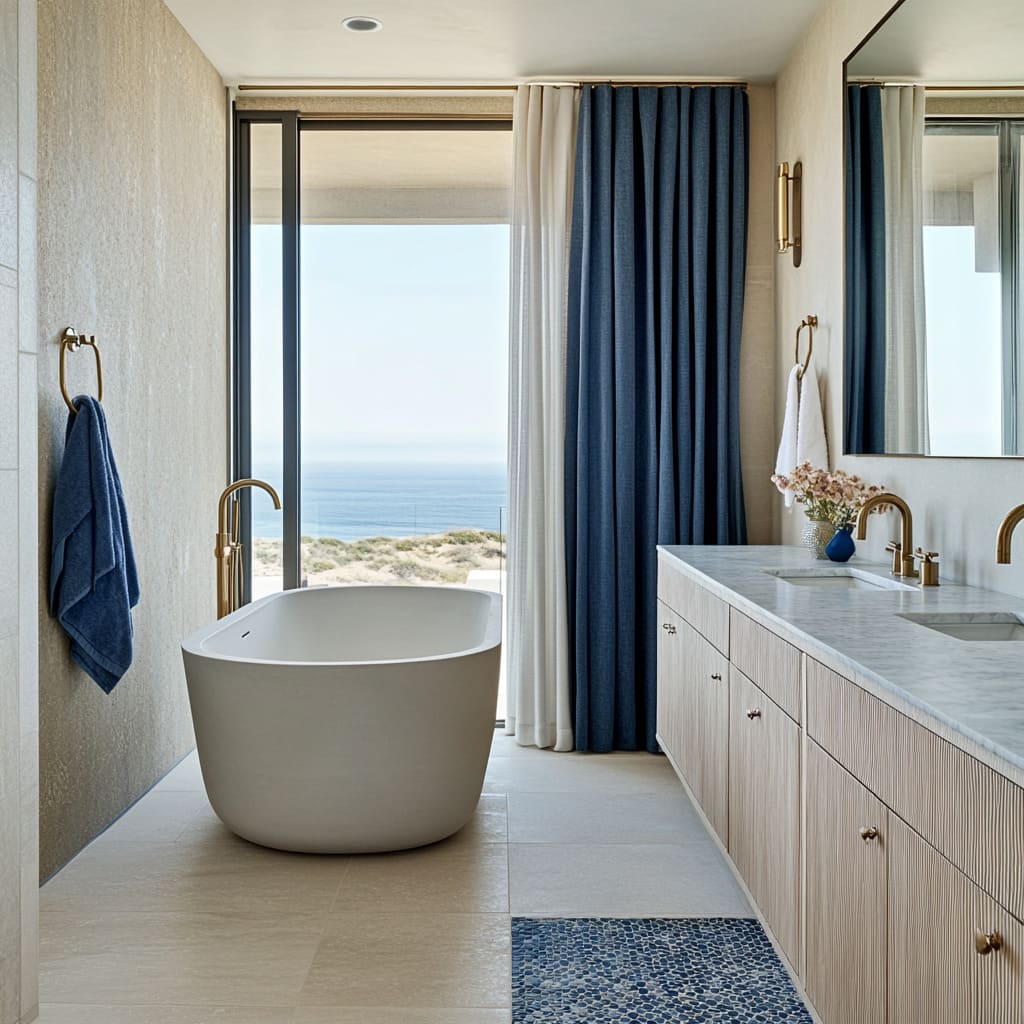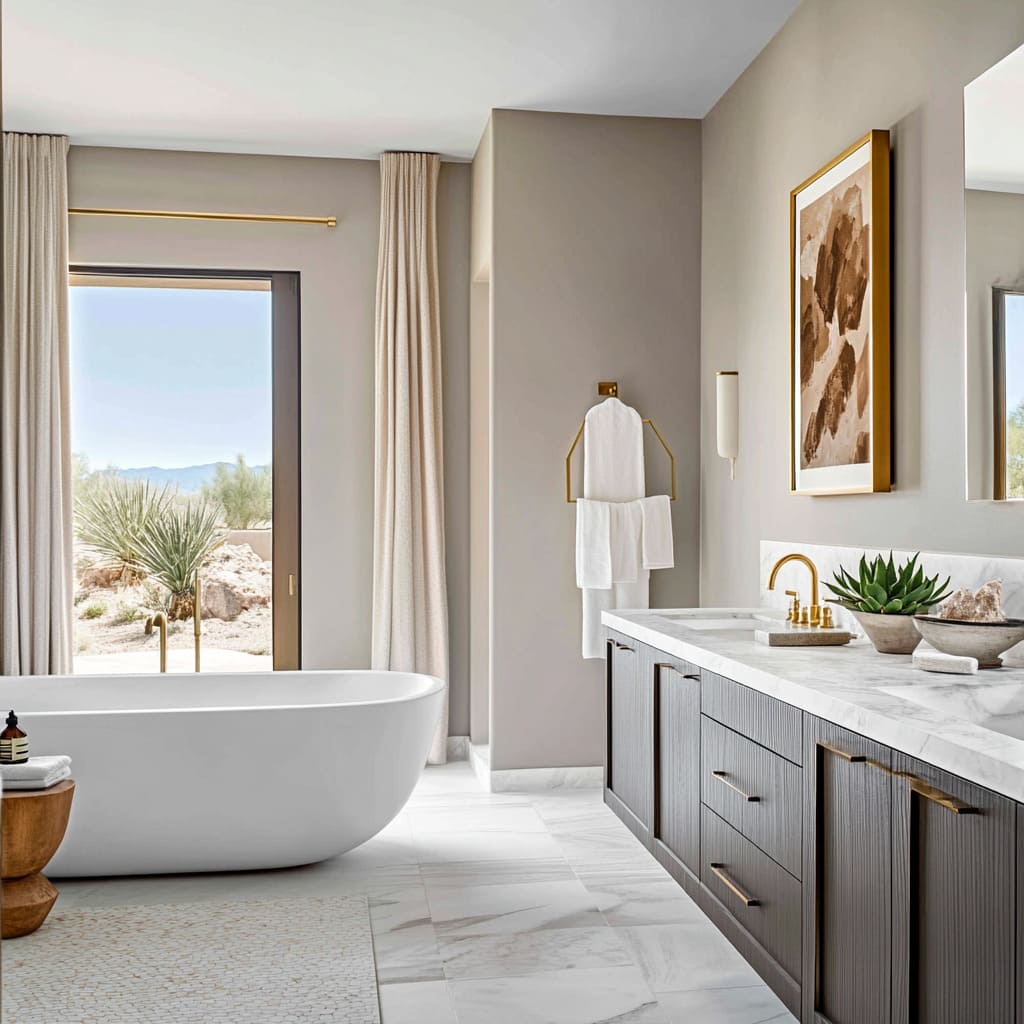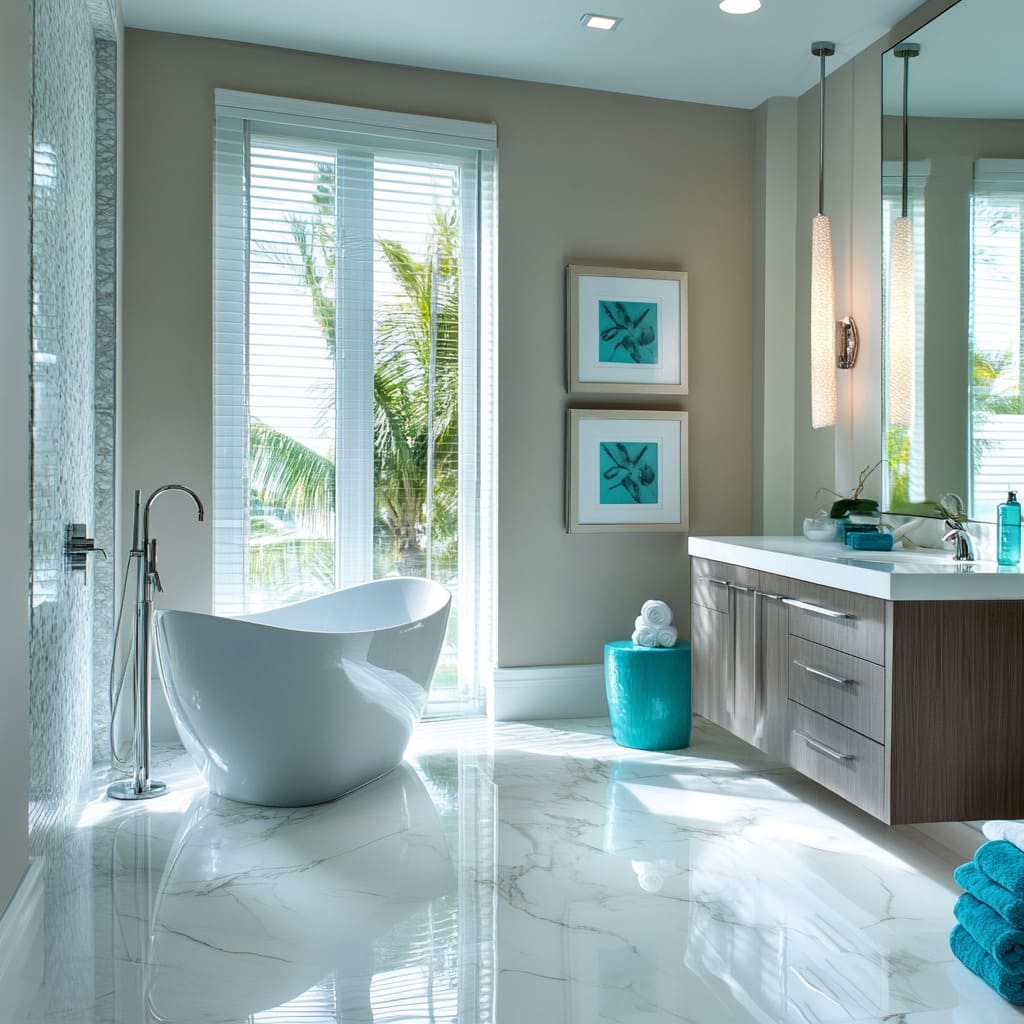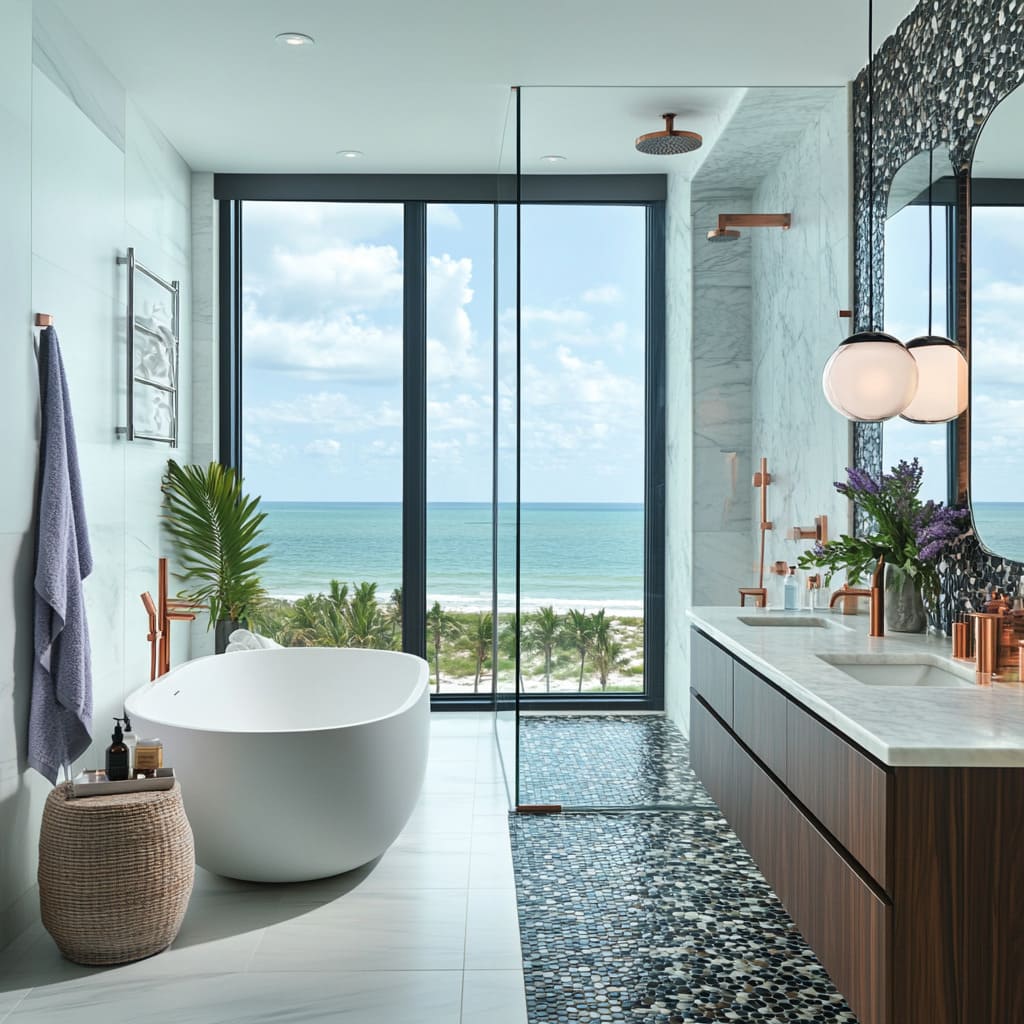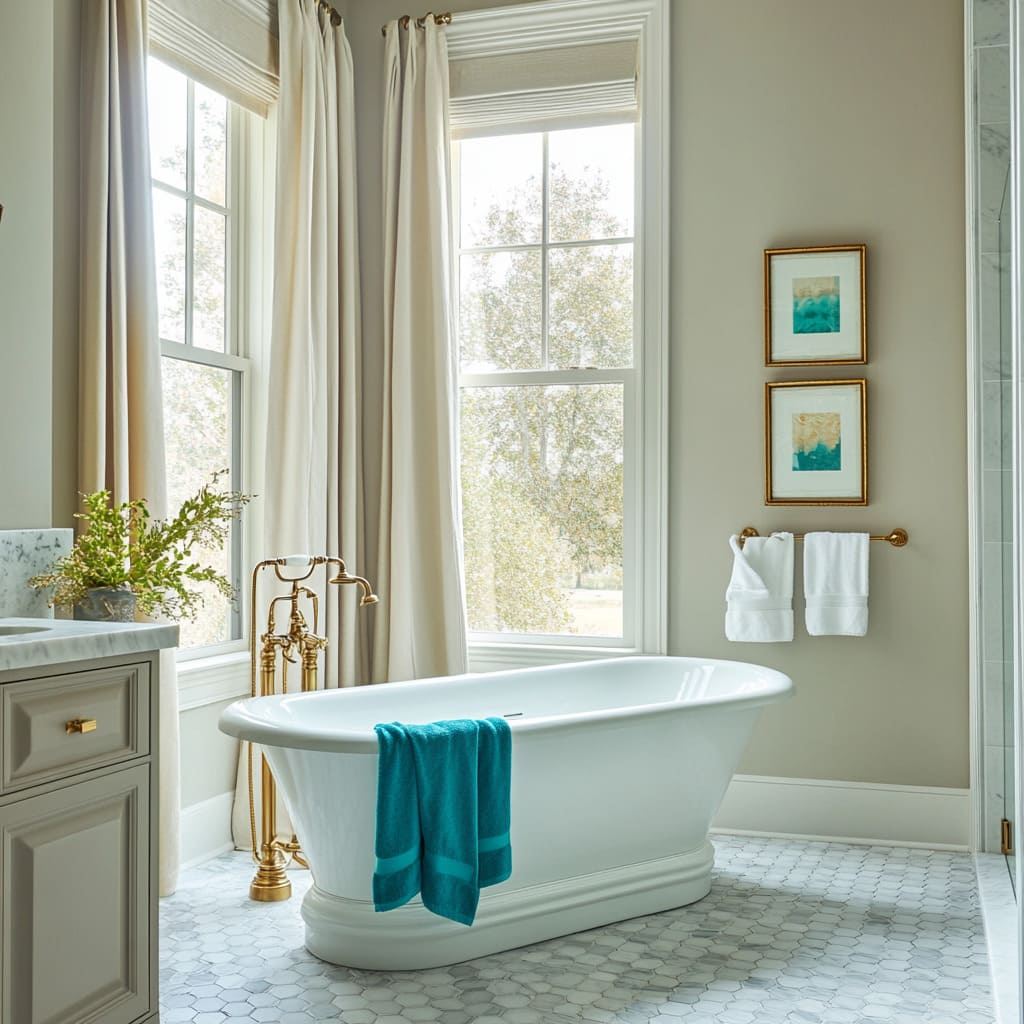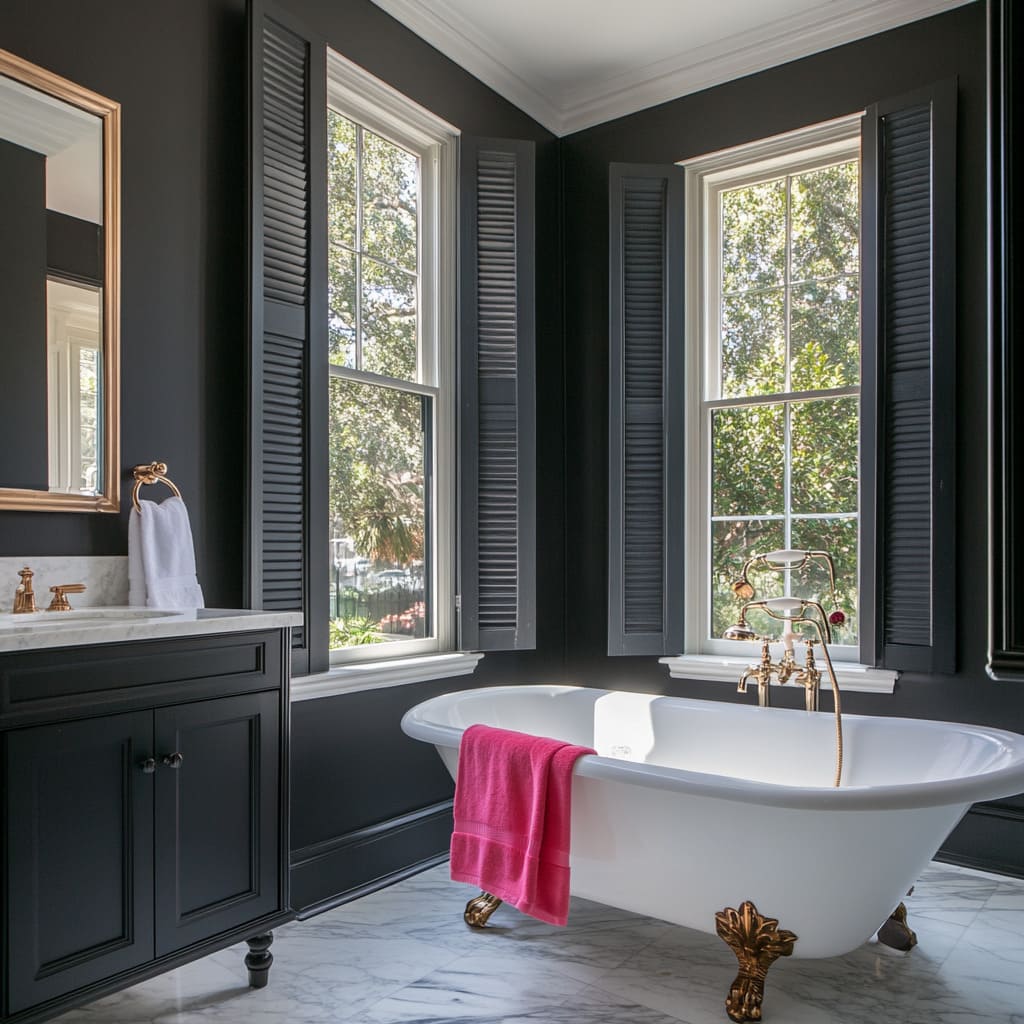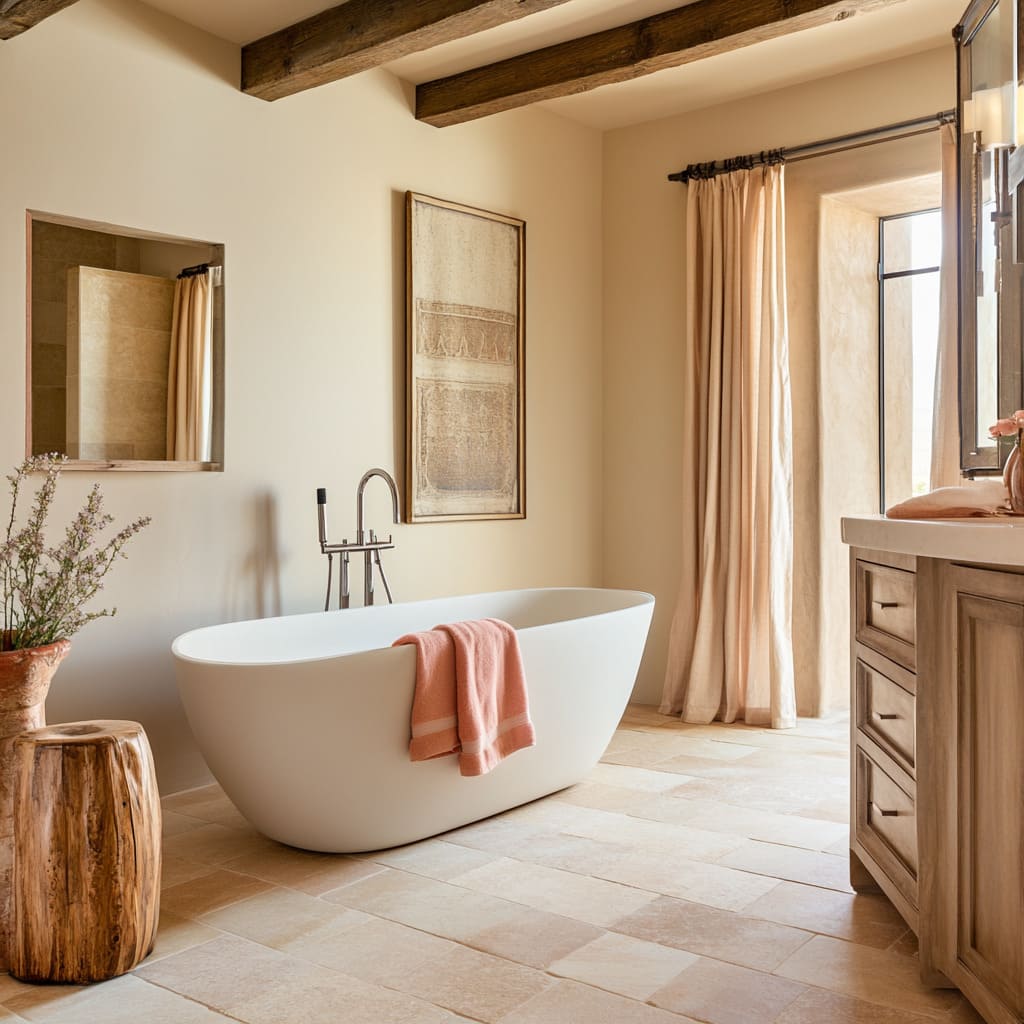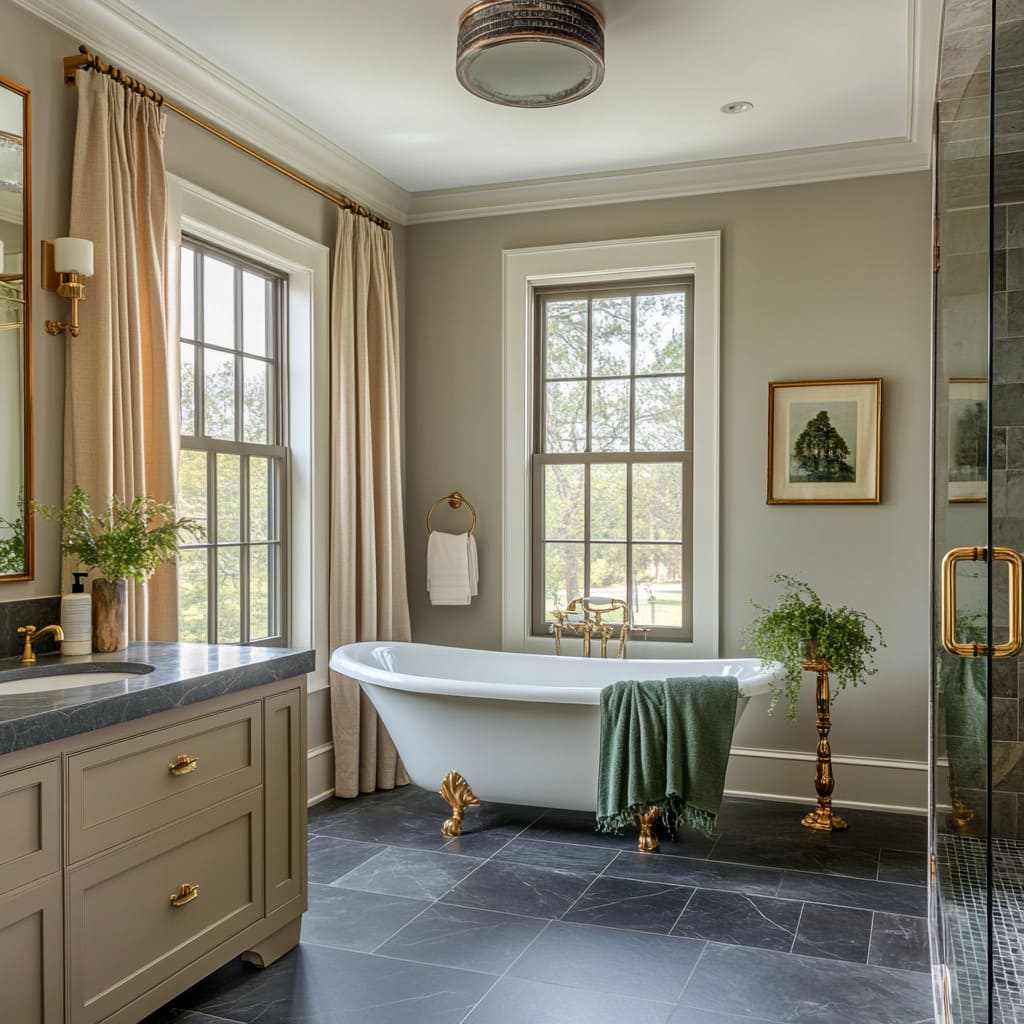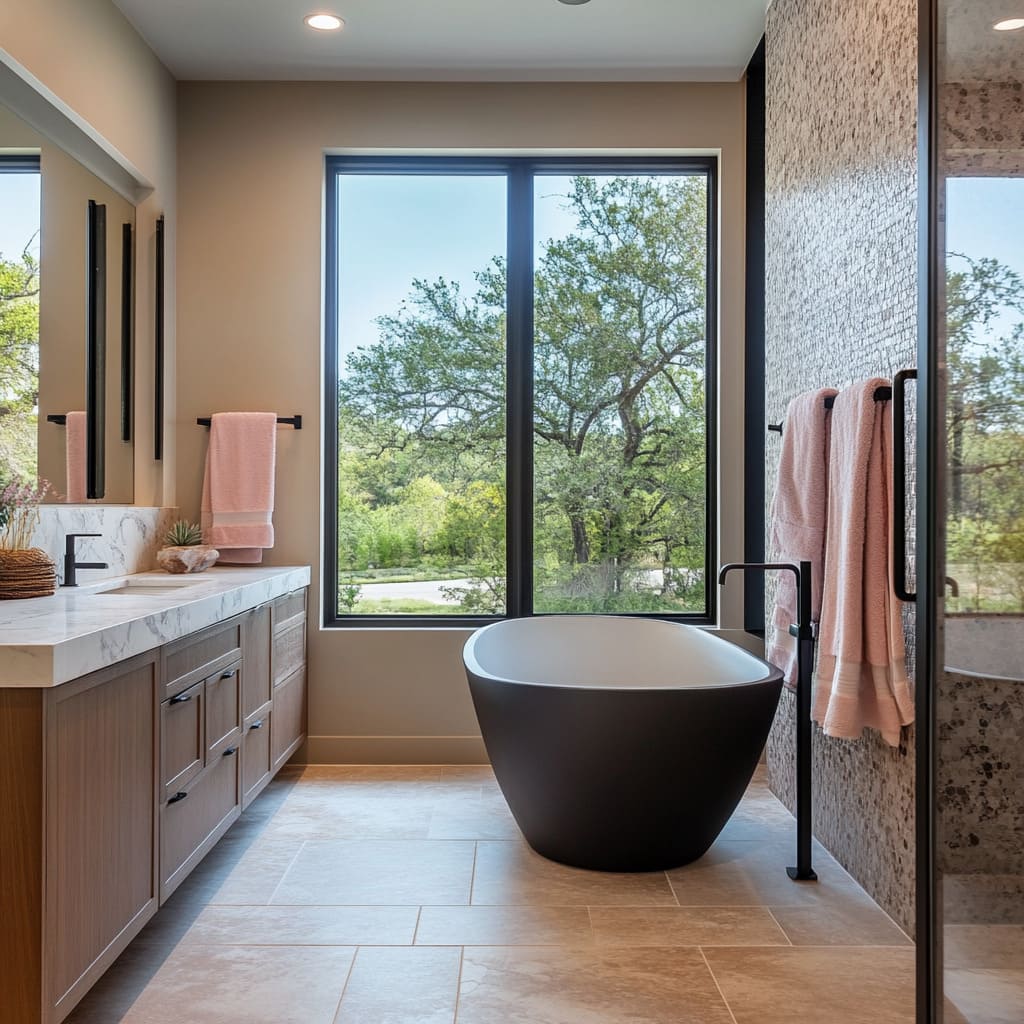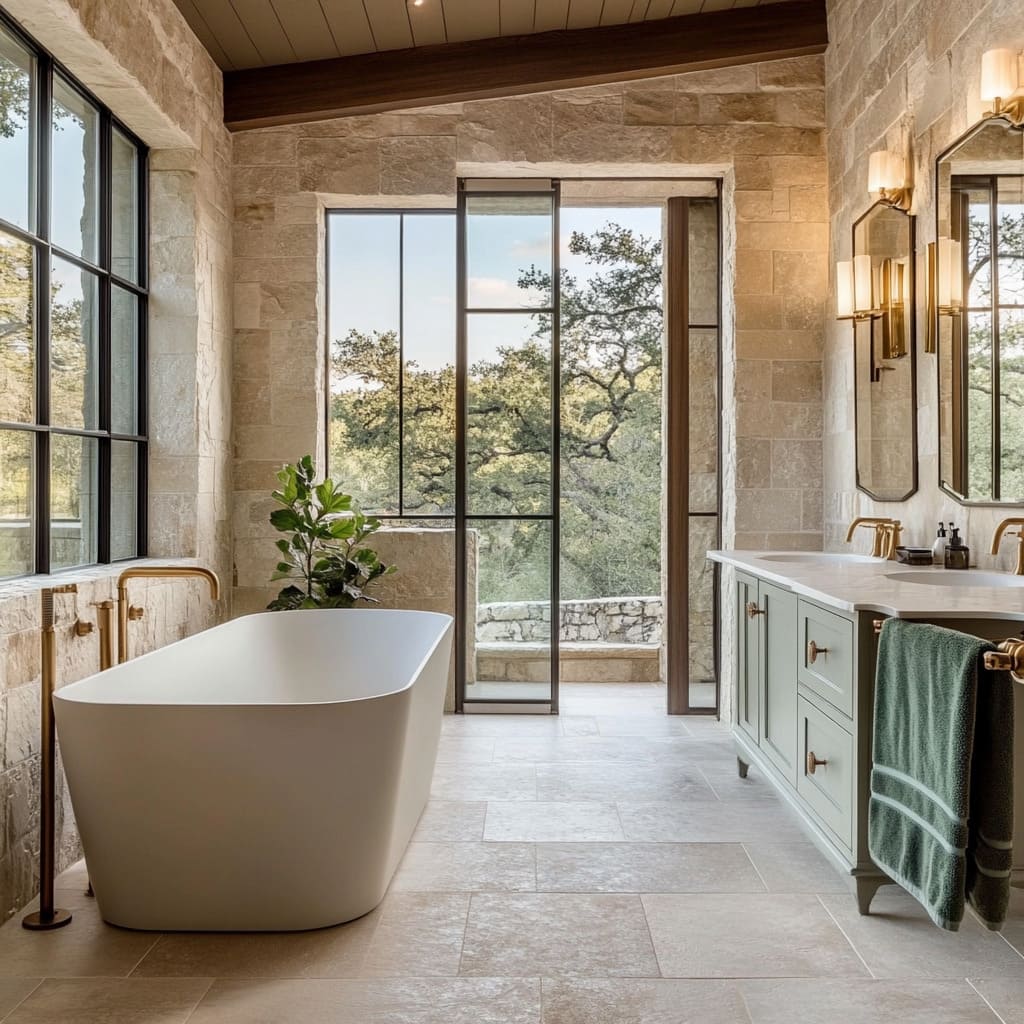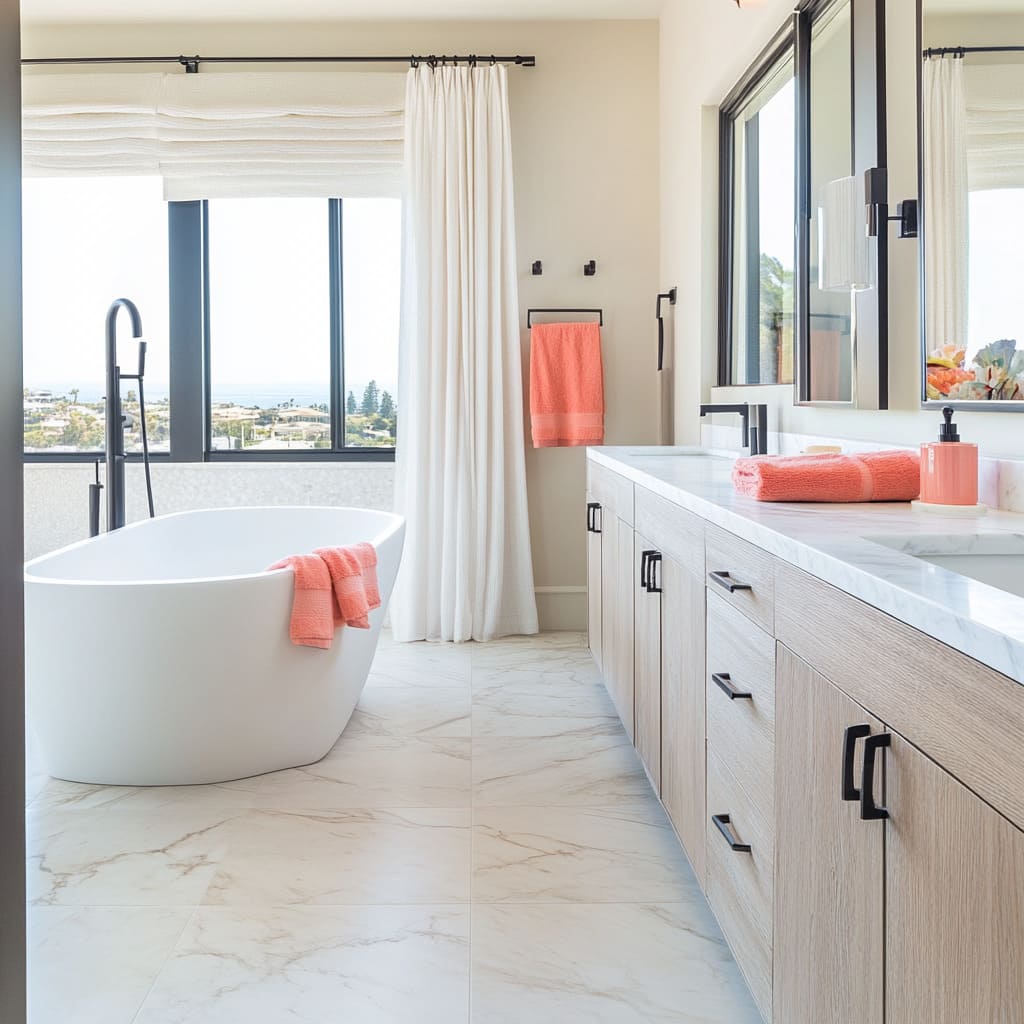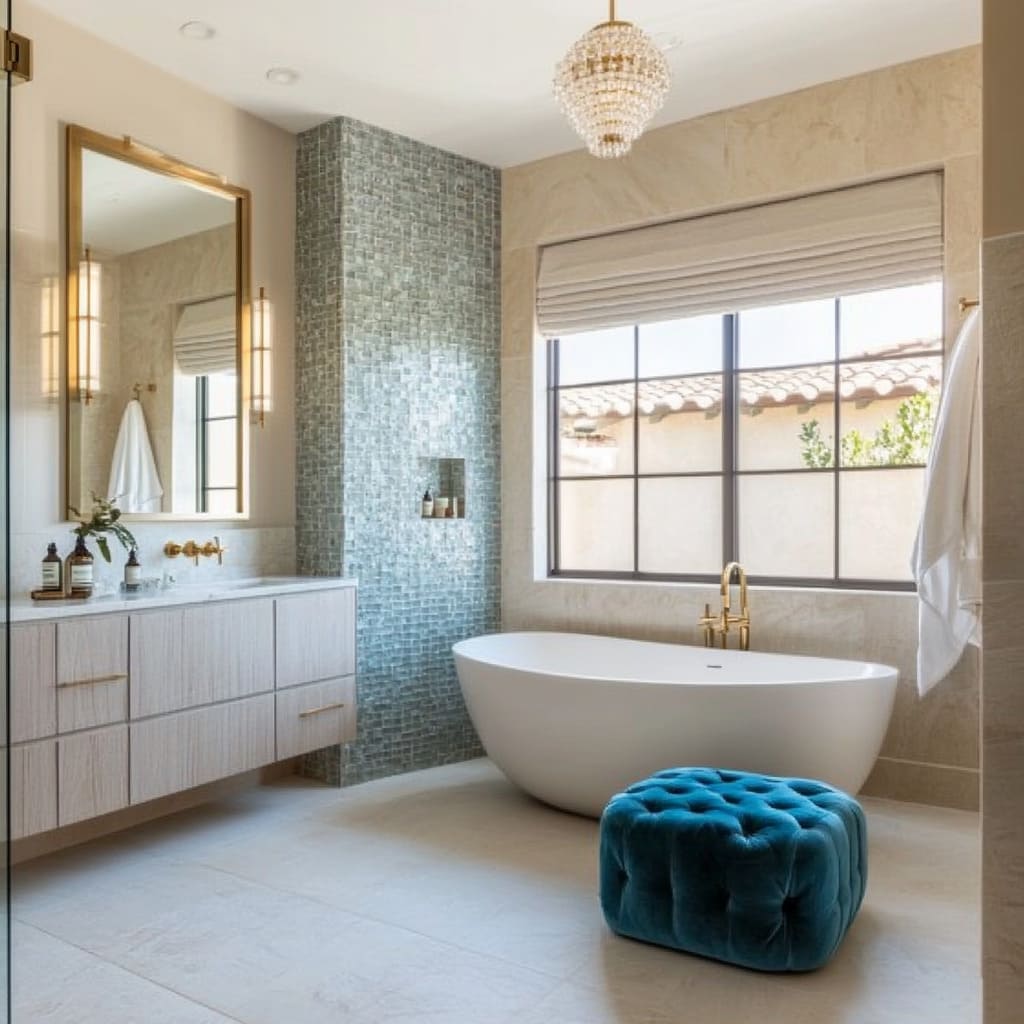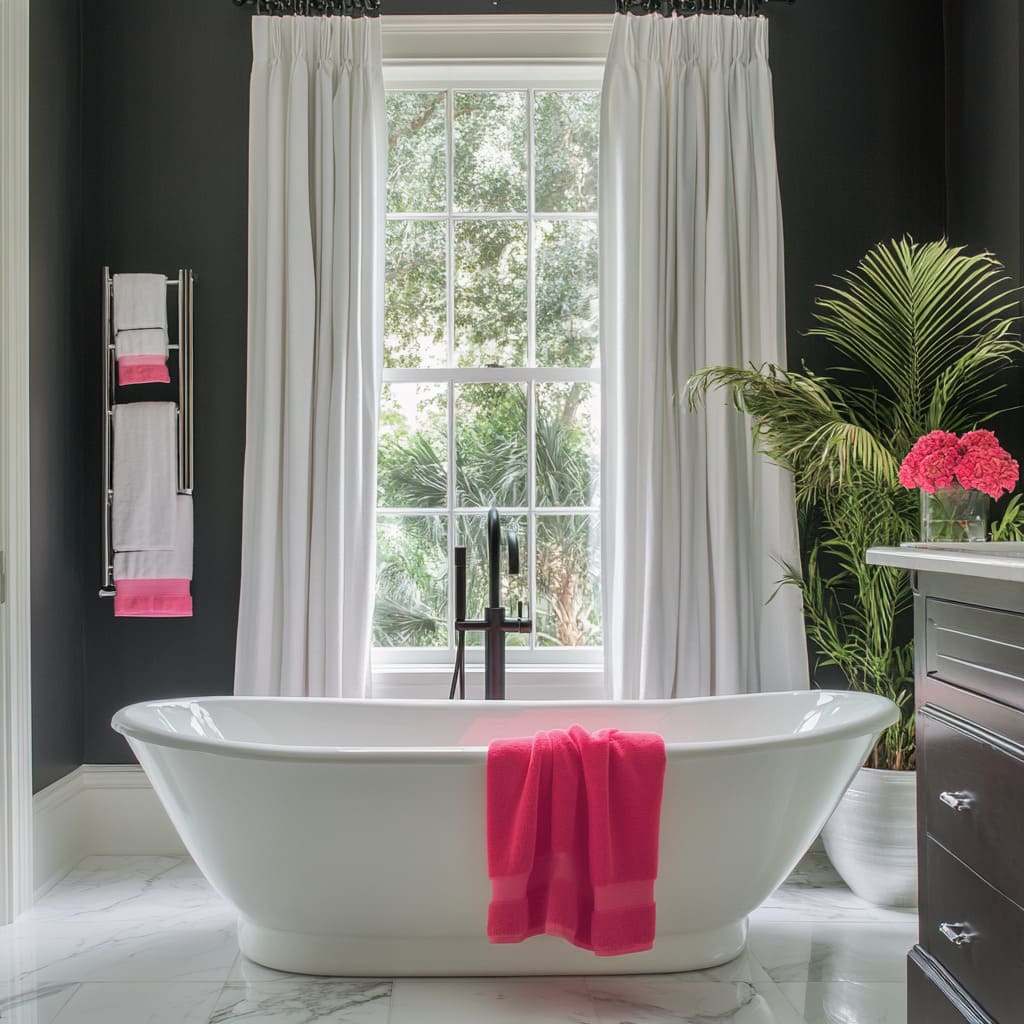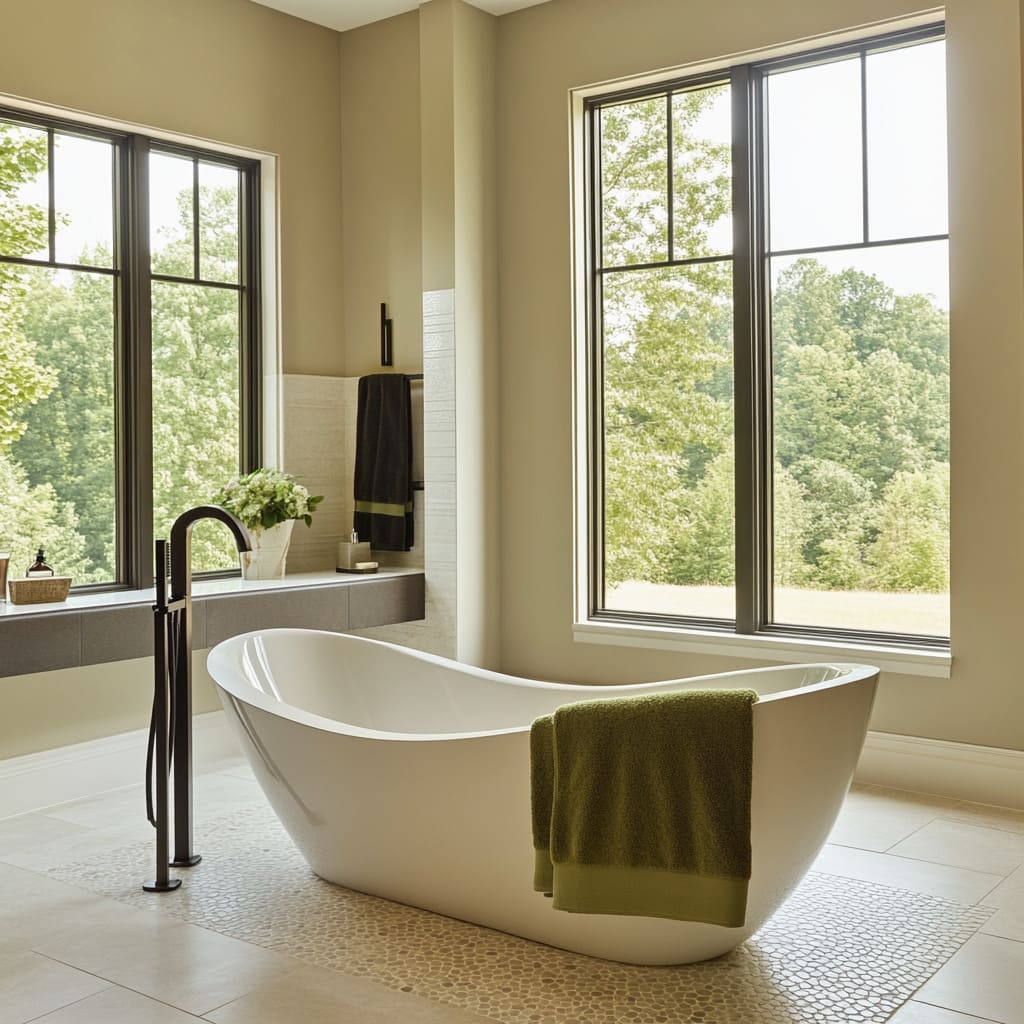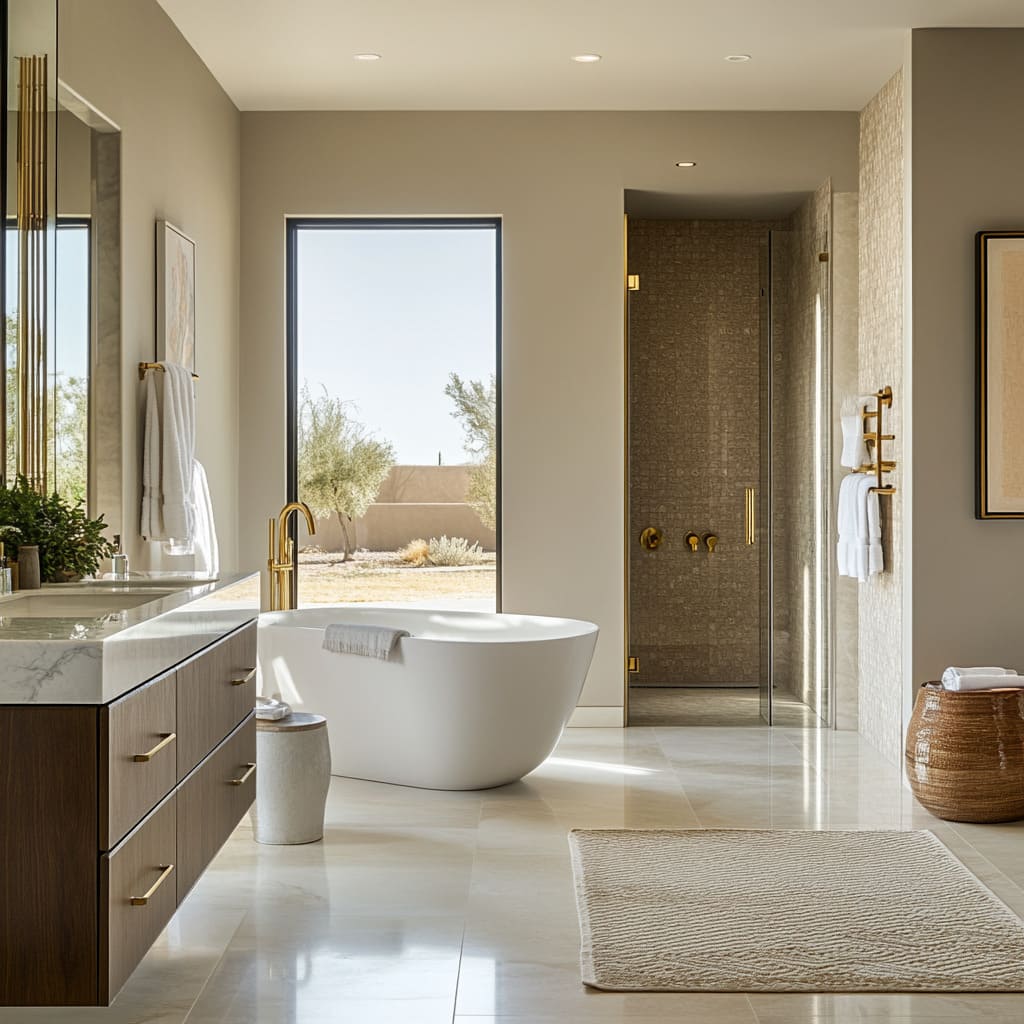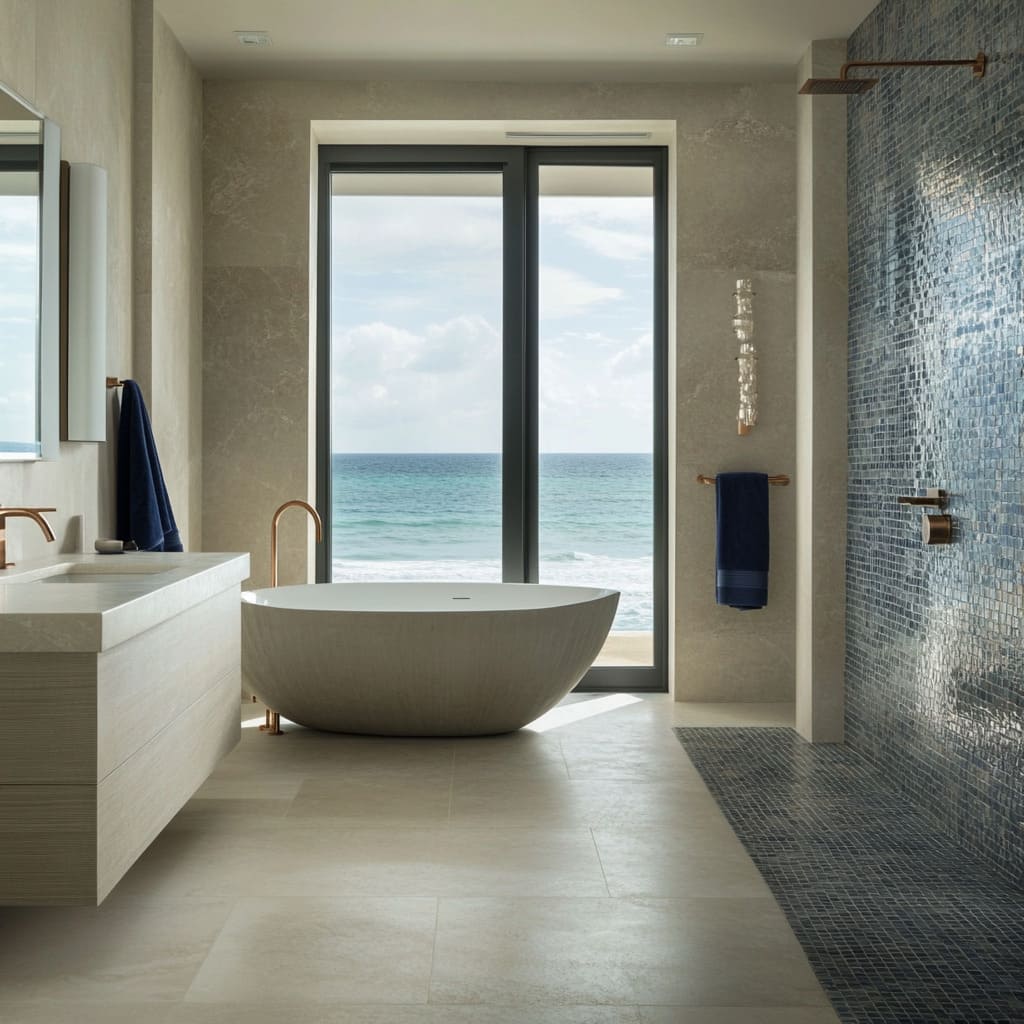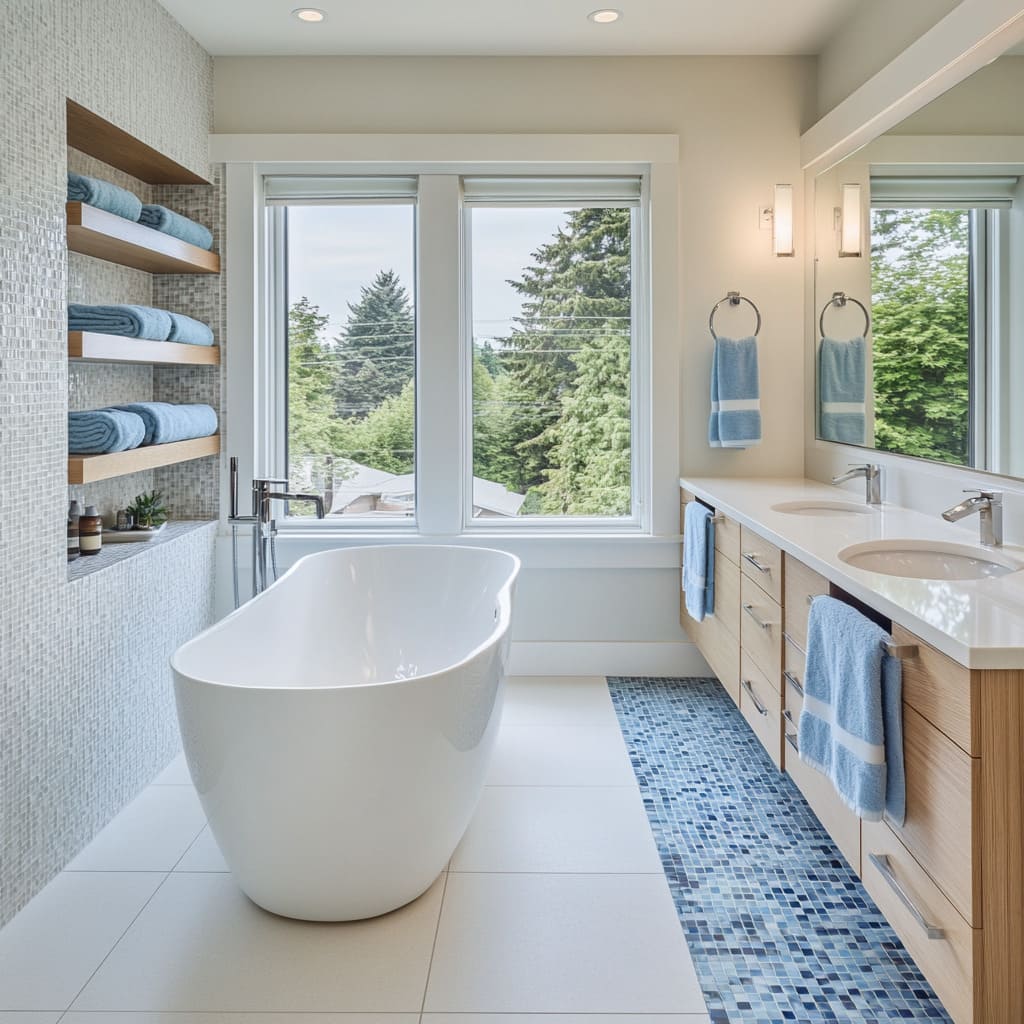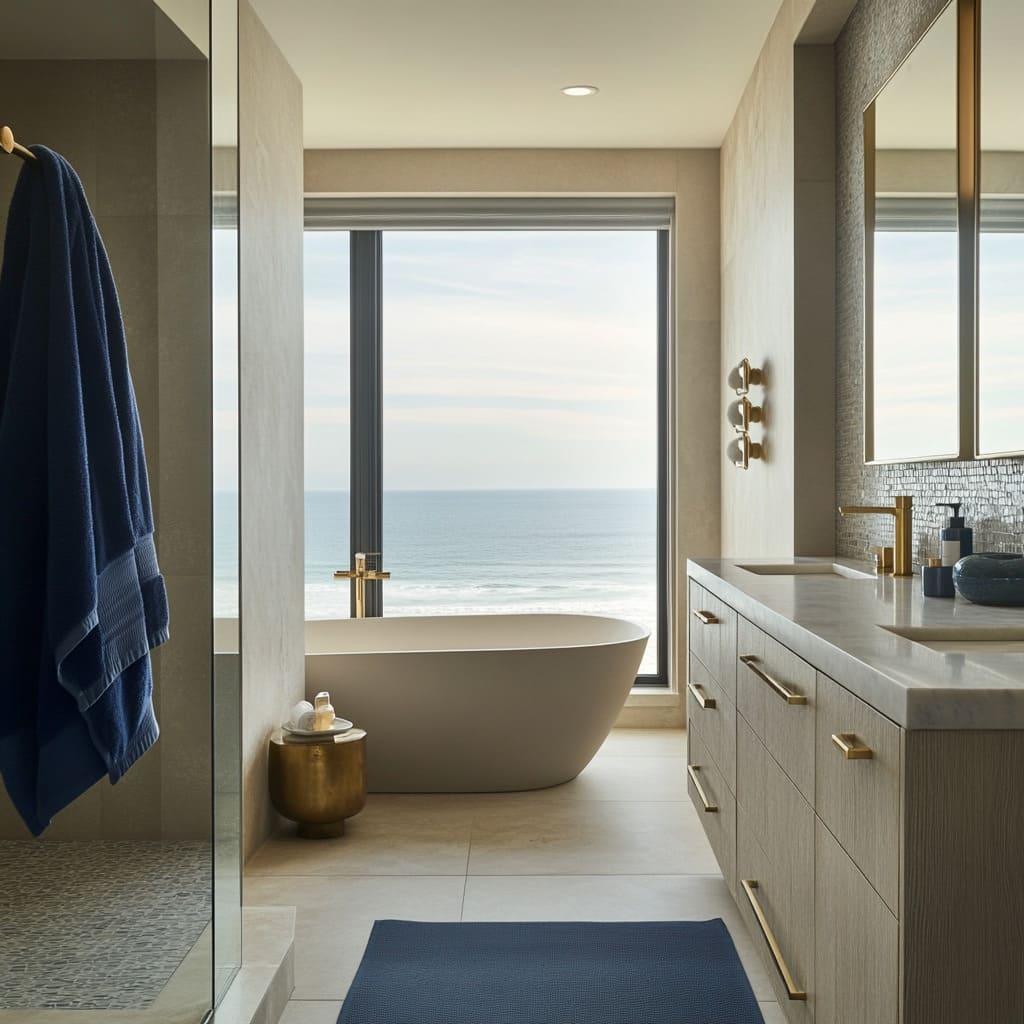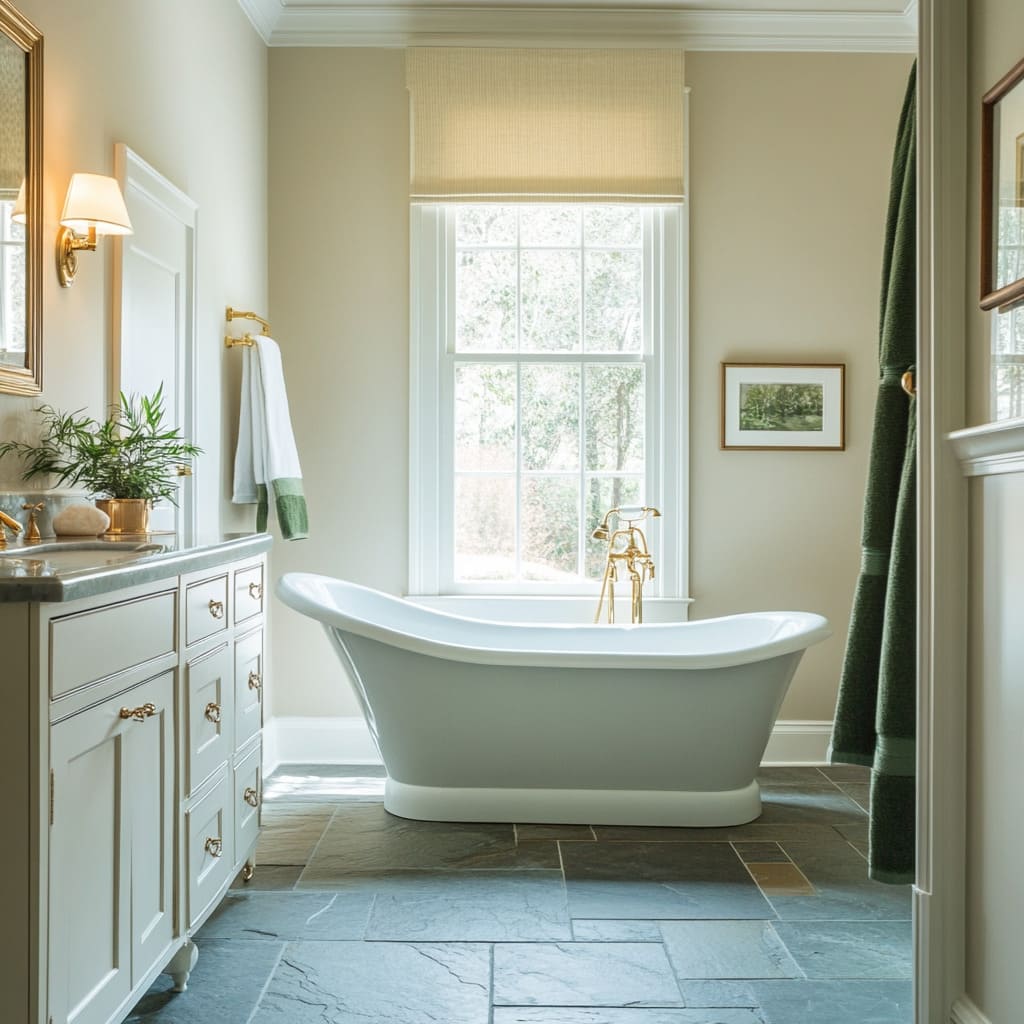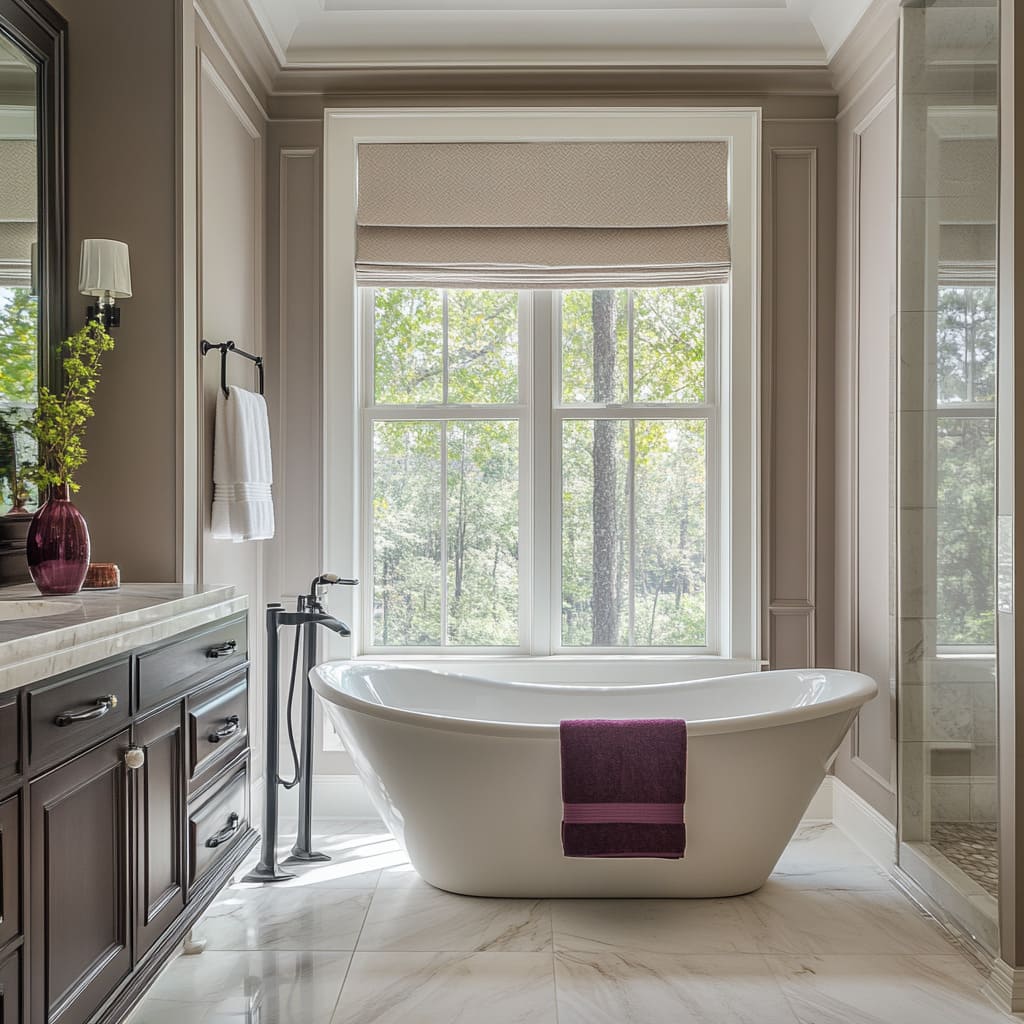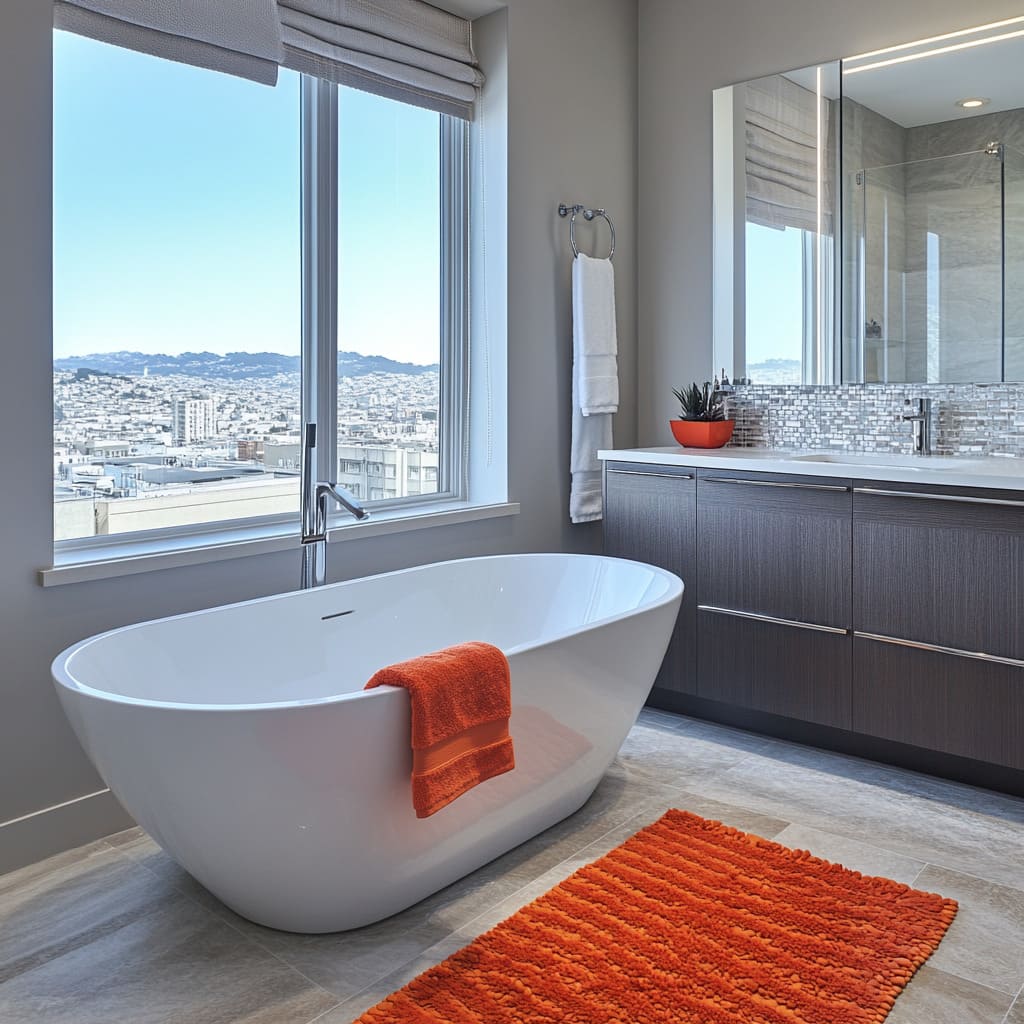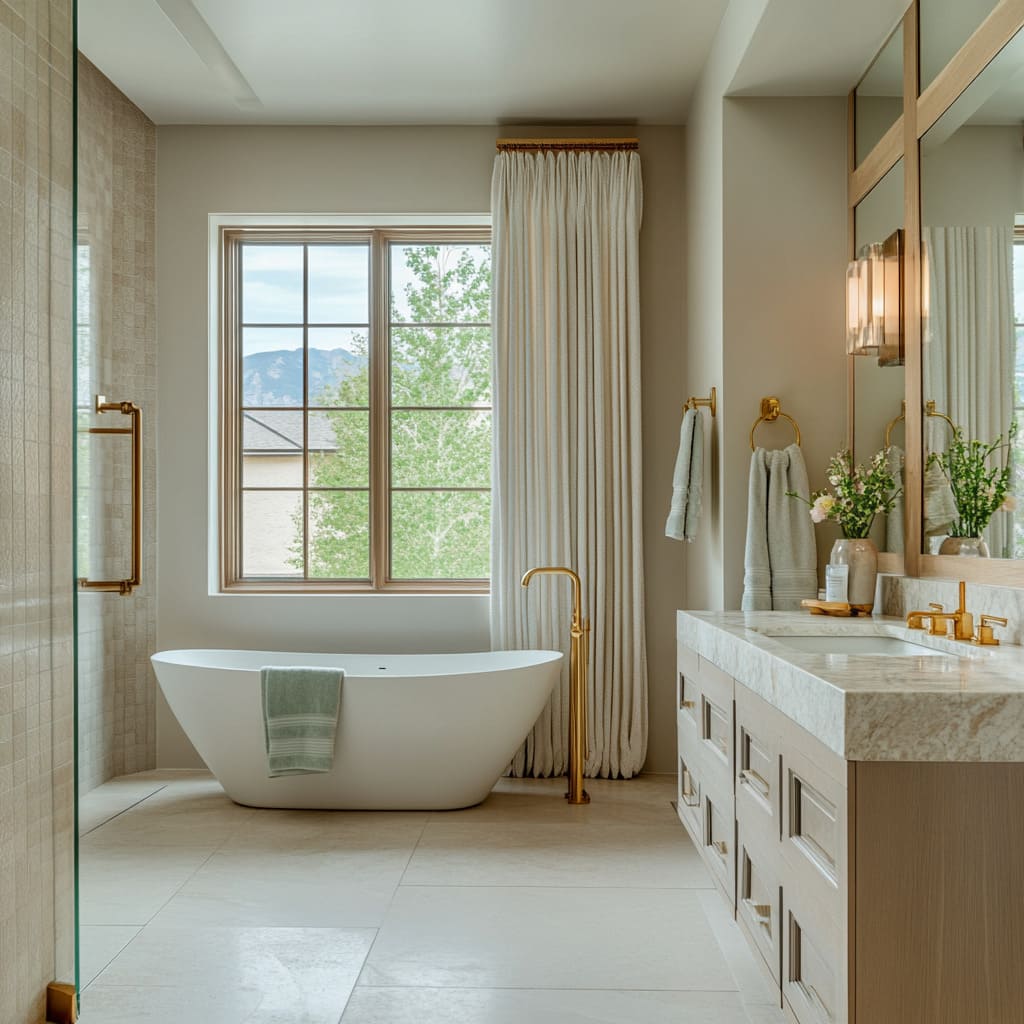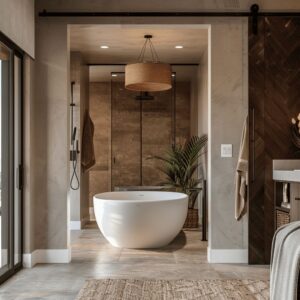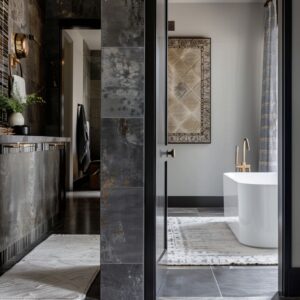American master bathrooms have evolved significantly over the years, moving from purely functional spaces to carefully designed retreats that reflect personal style and comfort. In today’s stylish American homes, master bathrooms are more than just places to refresh; they are private sanctuaries where homeowners seek relaxation and tranquility.
This shift in perspective has led to an emphasis on creating spaces that balance aesthetics with functionality, blending classic and contemporary elements to craft a bathroom that feels both timeless and current. One of the key trends in modern bathroom design is the strategic use of neutral colors.
Neutral tones—such as soft beige, warm taupe, cool gray, and ivory—serve as the foundation of the space, providing a calm and versatile backdrop. These hues are chosen for their ability to make a room feel open and airy while also allowing other design elements to stand out.
The use of neutral bathroom decor has become a cornerstone in achieving a look that is both sophisticated and adaptable, making it easy to introduce trendy accents without overwhelming the space
While neutrals provide the base, it’s the incorporation of trendy accent colors that brings personality and depth to the bathroom. These accent colors—ranging from deep teal to coral pink, navy blue to burnt orange—are strategically placed through items like towels, bath mats, and decorative vases.
This approach to bathroom color ideas allows homeowners to inject their personality into the space while maintaining the overall harmony of the design. The balance between the neutral foundation and the vibrant accents is crucial in creating a space that feels cohesive and thoughtfully designed
Color harmony is particularly important in bathroom design, as it can greatly influence the mood and functionality of the space. By carefully balancing bathroom paint colors with trendy accents, designers can create an environment that feels both restful and invigorating.
The right combination of colors can transform a bathroom from a purely utilitarian space into a welcoming retreat that invites relaxation. When selecting bathroom paint ideas, it’s essential to consider how the colors will interact with natural light, fixtures, and other elements in the room to create a cohesive and inviting atmosphere
The purpose of this article is to explore the various bathroom color design ideas that are shaping the look of stylish American master bathrooms today. We’ll delve into specific color combinations, discuss how different regions influence bathroom design, and examine the key elements that contribute to creating a harmonious and stylish bathroom.
Whether you’re looking to refresh your bathroom with a new coat of paint or completely redesign the space, this article will provide you with the inspiration and guidance you need to create a bathroom that balances classic elegance with modern trends
The Foundation of Neutral Colors in Bathroom Design
Choosing the Right Neutrals
Neutral colors are the cornerstone of modern bathroom design, providing a versatile foundation that can adapt to various styles and preferences. When selecting colors like soft beige, light gray, warm taupe, or cool white, you’re choosing shades that create a calm and inviting atmosphere, essential for a space meant for relaxation.
These colors are not only timeless but also highly adaptable, allowing them to work well in a range of design settings—from coastal to urban, and even rustic interiors
For a coastal-inspired bathroom, soft beige and warm taupe can evoke the natural beauty of sandy beaches and driftwood. These shades bring warmth and comfort, making the space feel inviting and cozy.
On the other hand, light gray and cool white are excellent choices for urban bathrooms, where a sleek and modern aesthetic is often desired. These colors can give the space a clean, uncluttered look while serving as the perfect backdrop for grey bathroom accents or metallic fixtures.
In a rustic bathroom, the earthy tones of warm taupe combined with natural wood elements can create a space that feels connected to the outdoors. The neutrality of these colors allows for flexibility when introducing textures and other design elements that contribute to the room’s overall character.
Whether you’re aiming for a spa-like retreat or a sophisticated urban oasis, choosing the right neutrals is the first step in setting the tone for your bathroom
Creating a Harmonious Backdrop
Once you’ve selected your neutral palette, the next step is to create a harmonious backdrop that ties the entire bathroom together. Neutral walls and flooring are fundamental in establishing a cohesive look, serving as a canvas that enhances the overall aesthetic without overwhelming it.
These elements are crucial in ensuring that the space feels balanced and unified. When considering bath color ideas, it’s important to think about how the walls and flooring will interact with other components of the bathroom, such as fixtures, countertops, and cabinetry.
For example, soft beige walls paired with light stone tiles can create a warm, inviting space that feels both contemporary and timeless. This combination is particularly effective in bathrooms where you want to introduce accent color for grey bathroom elements, such as dark wood or matte black fixtures, without disrupting the overall harmony.
In bathrooms where you’re looking to incorporate accent walls, neutral tones can provide a subtle contrast that adds depth and interest to the space. Accent wall ideas for bathroom designs might include using a slightly darker shade of the same neutral color, creating a focal point without breaking the flow of the room.
For instance, a soft gray accent wall behind a freestanding tub can draw attention to the area while maintaining the calming effect of the overall palette
Tiles, countertops, and wall colors should all work in concert to create a seamless look. In this context, bath paint ideas should focus on finding shades that complement rather than compete with each other.
For example, if your walls are a cool white, consider pairing them with a slightly warmer countertop or tile to introduce a subtle contrast that adds interest without overpowering the space. The key is to ensure that all elements work together to create a unified and inviting environment.
In summary, neutral colors are essential in laying the foundation for a stylish and cohesive bathroom. By carefully choosing and coordinating these shades, you can create a space that not only feels balanced and harmonious but also serves as a flexible backdrop for introducing trendy accents and personal touches.
Whether you’re drawn to the tranquility of soft beige or the modern appeal of cool gray, the right neutrals can transform your bathroom into a space that is both timeless and on-trend
See What Your Budget Can Do for Your Bathroom
Curious about how much you can improve your bathroom? From a fresh coat of calming blue to modern fixtures, use our calculator to explore your options.
[budget_renovation_calculator]
Integrating Trendy Accent Colors for Visual Interest
The Power of Accent Colors
In the world of interior design, accent colors hold the power to transform a neutral bathroom from understated to visually captivating. While neutral tones like soft beige, light gray, and cool white provide a calming and cohesive base, it’s the introduction of trendy accent colors that injects personality and depth into the space.
By carefully choosing and placing these colors, homeowners can create a bathroom that reflects their style and brings a sense of energy to the room
Accent colors play a crucial role in adding character to what might otherwise be a monochromatic space. Popular bathroom colors such as deep teal, burnt orange, navy blue, coral pink, and forest green have become favorites in stylish American homes.
These shades offer a bold contrast to the neutral backdrop, drawing attention to specific areas and features of the bathroom. For instance, a bathroom with soft gray walls might come alive with the addition of deep teal towels or a burnt orange bath mat, creating a striking visual interplay that enhances the overall design
The best bathroom colors are those that not only complement the existing neutral tones but also add a layer of richness and vibrancy. For example, navy blue can be an excellent choice for those looking for blue bathroom ideas that are both classic and contemporary.
This color works beautifully with both cool and warm neutrals, making it a versatile option for a variety of bathroom styles. Whether used in a small bathroom or a spacious master suite, the right accent color can significantly elevate the space, making it feel both stylish and inviting
Strategic Placement of Accent Colors
The strategic placement of accent colors is key to achieving a balanced and visually appealing bathroom design. Introducing these colors through carefully chosen decor items allows homeowners to experiment with trends without making permanent changes.
Towels, bath mats, vases, and other accessories are perfect candidates for incorporating accent colors in a way that feels intentional and cohesive. In the vanity area, for example, a simple vase in coral pink or forest green can add a pop of color that draws the eye and ties together the room’s design elements.
Towels are another easy way to introduce accent colors—navy blue towels against a backdrop of light gray tiles can create a stunning contrast that feels both bold and refined. In smaller bathrooms, where space is limited, choosing a standout accent color for the towels or bath mat can be one of the best small bathroom color ideas, adding interest without overwhelming the space
Around the tub, accent colors can be used to create a focal point that enhances the bath experience. A bath mat in burnt orange placed near a freestanding tub against a cool white wall can create a warm and inviting atmosphere, perfect for relaxation.
Similarly, placing a few vases or candles in trendy hues around the tub area can bring a touch of luxury and personalization to the bathroom. In the shower, accent colors can be introduced through mosaic tiles or even small decorative items.
For those considering grey bathroom ideas, adding a row of deep teal or navy blue tiles within a predominantly gray shower can create a striking visual contrast that adds depth and dimension to the space. This approach is especially effective in maintaining a cohesive look while still allowing the accent color to stand out.
Overall, the thoughtful integration of accent colors into a neutral bathroom design can transform the space into something truly special. By carefully selecting the right colors and placing them strategically, homeowners can create a bathroom that feels dynamic and engaging, yet balanced and cohesive.
Whether you’re looking to refresh your current bathroom or designing a new one, incorporating trendy accent colors is a simple yet powerful way to enhance the space and reflect your personal style
Regional Influences on Bathroom Design
Coastal Elegance
Coastal regions like Newport Beach, Laguna Beach, and Miami have a significant impact on bathroom design, reflecting the easygoing yet refined lifestyle that these locations are known for. In these areas, the design ethos is all about capturing the natural beauty of the seaside, translating it into light, airy interiors that evoke a sense of relaxation and openness.
Coastal bathrooms often feature a palette of soft neutrals, such as cool white, light sand, and modern beige, providing a fresh and calming backdrop that mimics the natural hues of the shoreline
To bring in the essence of the ocean, designers frequently incorporate accent colors inspired by the sea. Aqua blues, deep navies, and vibrant corals are popular choices, adding a splash of color that enlivens the neutral base.
For example, navy blue bathroom ideas might include towels, bath mats, or even mosaic tiles, creating a sophisticated yet relaxed atmosphere that feels both timeless and modern. Coral bathroom decor can be introduced through accessories like vases, soap dispensers, and artwork, adding warmth and a pop of color that complements the surrounding neutrals
Large windows are a staple in coastal bathroom design, allowing natural light to flood the space and enhancing the feeling of openness. These windows often frame breathtaking views of the ocean, making the bathroom feel connected to the outdoors.
Sleek freestanding tubs are another key feature, offering a luxurious spot to unwind while taking in the scenery. The fixtures in these bathrooms tend to be minimalist yet high-end, with chrome, brushed nickel, or even matte black finishes that add a touch of modern luxury without overwhelming the space
Southern Charm
Southern bathrooms, particularly those in cities like Charleston, Savannah, and Nashville, are characterized by a blend of traditional elegance and warm, welcoming vibes. These bathrooms often feature a foundation of warm neutrals, such as soft beige, taupe, and ivory, which create a comforting and inviting atmosphere.
The addition of rich, earthy accent colors—such as sage green, burgundy, and gold—adds depth and character to the space, reflecting the region’s appreciation for timeless beauty
Green bathroom ideas are especially popular in the South, with shades like sage and olive being used to bring a touch of nature indoors. These greens work beautifully with warm wood tones, antique-style mirrors, and classic vanities, creating a space that feels both grounded and refined.
Burgundy bathroom decor, including plush towels, curtains, or even a feature wall, adds a sense of richness and drama, perfectly complementing the softer neutral tones. Gold and white bathroom decor is another staple in Southern design, often seen in lighting fixtures, faucets, and hardware, adding a touch of elegance and warmth.
Lighting is a key element in Southern bathrooms, with chandeliers or sconces often used to create a soft, ambient glow that enhances the room’s warm tones. These elements, combined with traditional design features like clawfoot tubs and ornate mirrors, contribute to a bathroom that feels both classic and luxurious, embodying the charm and grace that the South is known for
Urban Sophistication
In urban environments like Chicago, New York City, and San Francisco, bathroom design tends to lean towards sleek, modern aesthetics that reflect the fast-paced, cosmopolitan lifestyle of these cities. These bathrooms often feature a palette dominated by cool grays, charcoals, and whites, creating a clean and polished look that is both sophisticated and minimalist.
Mustard and grey bathroom combinations are particularly popular in these settings, offering a contemporary contrast that adds warmth and vibrancy to an otherwise monochromatic space
The use of bold accent colors is a hallmark of urban bathroom design. Teal and mustard are among the best bathroom colors for small bathrooms, as they add a striking contrast without overpowering the space.
These colors might be introduced through tiles, cabinetry, or even art, providing a focal point that draws the eye and adds interest. In a small city bathroom, for instance, a mustard accent wall could create a lively yet refined atmosphere, while teal accessories might be used to add a pop of color to a predominantly gray space
High-end materials and finishes are essential in creating the luxurious feel of an urban bathroom. Think sleek marble countertops, frameless glass showers, and modern fixtures in polished chrome or matte black.
The emphasis is on clean lines and a clutter-free environment, making the bathroom feel like a serene escape from the city’s hustle. The combination of these elements results in a bathroom that is not only stylish but also functional, reflecting the sophistication and efficiency of urban living
Mountain and Desert Serenity
Mountain and desert regions, such as Denver, Aspen, and Santa Fe, offer a unique take on bathroom design, drawing inspiration from the natural landscapes that surround them. In these areas, earthy tones and organic materials take center stage, creating spaces that feel connected to nature.
Warm neutrals like light stone, sandy beige, and soft gray provide a soothing backdrop, while accents in peach, forest green, and deep browns add warmth and depth
For those exploring green bathroom ideas, forest green is a perfect choice in these environments, evoking the rich colors of the surrounding forests. This color can be incorporated through tiles, cabinetry, or even plants, adding a fresh, natural element to the bathroom.
Peach is another popular accent color in mountain and desert settings, often seen in towels, rugs, or wall art, adding a soft, warm contrast to the earthy tones. This combination of colors not only enhances the natural beauty of the space but also creates a sense of tranquility and relaxation
Design elements in these bathrooms often include materials that reflect the natural surroundings, such as stone tiles, wood vanities, and large windows that offer sweeping views of the mountains or desert. The use of organic materials adds texture and warmth, creating a bathroom that feels both luxurious and grounded.
These spaces are designed to be retreats, where the outside world feels close yet distant, allowing for relaxation and rejuvenation in a setting that mirrors the natural beauty of the region
In conclusion, regional influences play a significant role in shaping the design of stylish American bathrooms. From the coastal elegance of Newport Beach to the urban sophistication of New York City, each region brings its own unique flavor to bathroom design, resulting in spaces that are not only beautiful but also deeply connected to their surroundings.
By understanding these influences and how they impact color and material choices, homeowners can create bathrooms that reflect their personal style while staying true to the character of their location
Key Design Elements in Stylish American Bathrooms
Freestanding Tubs
Freestanding tubs have become a signature feature in modern master bathrooms, serving as both functional fixtures and striking focal points. Unlike built-in tubs, freestanding models stand alone, offering a sense of luxury and refinement that elevates the overall design of the bathroom.
Whether sleek and minimalist or classic and elegant, these tubs can significantly impact the bathroom’s aesthetic, drawing the eye and setting the tone for the entire space
In contemporary bathrooms, a minimalist freestanding tub with clean lines and a simple silhouette often complements a neutral palette of cool whites and soft grays. For example, in gray bathroom ideas, a white freestanding tub can create a stunning contrast against a backdrop of gray walls or tiles, adding a sense of balance and sophistication.
The tub’s placement is crucial; positioned near a large window, it can become a central feature that offers relaxation with a view, making it not just a practical choice but also a design statement
For those who prefer a more traditional or elegant look, freestanding tubs with clawfoot or pedestal bases are excellent options. These tubs often pair well with classic materials like marble or wood, enhancing the bathroom’s timeless appeal.
In bathrooms where color plays a more significant role, choosing a freestanding tub in a soft, neutral hue can tie together the room’s various elements, allowing for a seamless integration of the tub into the overall design. This approach works well in bathroom ideas with color, where the tub complements rather than competes with other design features
Vanities and Countertops
Vanities are another critical element in bathroom design, serving as both functional storage solutions and key components of the room’s visual appeal. The choice of materials and finishes for the vanity can greatly influence the bathroom’s overall look, making it essential to select options that harmonize with the color palette and other design elements
Wooden vanities, for instance, bring warmth and texture to the space, making them a popular choice in bathrooms with earthy or rustic themes. Paired with stone or marble countertops, these vanities can create a sense of balance between natural and refined materials, resulting in a bathroom that feels both cozy and elegant.
In contrast, vanities with a high-gloss or lacquered finish can add a touch of modernity, especially when combined with sleek, minimalist countertops
Countertops themselves are a major consideration in bathroom design, as they can either blend into the background or serve as a focal point. Marble is a timeless choice, known for its luxurious appearance and subtle veining, which adds depth and interest without overwhelming the space.
Stone countertops, such as granite or quartz, offer durability and a wide range of colors and patterns, making them versatile options for various bathroom color suggestions. For those seeking a more natural or organic look, wooden countertops can add warmth and texture, creating a welcoming atmosphere.
The key is to select vanities and countertops that not only suit the bathroom’s aesthetic but also enhance its functionality. A well-chosen vanity can anchor the room, providing both storage and style, while the right countertop material can elevate the bathroom’s overall design, tying together the color scheme and other elements
Fixtures and Hardware
Fixtures and hardware are the finishing touches that can make or break a bathroom’s design. These elements—such as faucets, showerheads, towel bars, and drawer pulls—may seem small, but they play a significant role in tying the room together and adding the final layer of polish.
When choosing fixtures, it’s important to consider both their finish and style. Brass fixtures, for example, can add a touch of warmth and luxury to a bathroom, making them an excellent choice for traditional or elegant spaces.
Chrome and polished nickel, on the other hand, are timeless and versatile, often used in modern or minimalist bathrooms for their sleek, reflective qualities. Matte black fixtures have gained popularity in recent years for their ability to add a bold, contemporary edge, particularly in bathrooms with a monochromatic palette
The selection of fixtures should be in harmony with the overall design, whether they blend into the neutral background or stand out as accent features. For example, in a bathroom with a predominantly white and gray color scheme, matte black fixtures can provide a striking contrast, adding depth and interest without overwhelming the space.
In a bathroom where the focus is on warm tones, such as those found in modern beige bathroom ideas, brass fixtures can enhance the room’s warmth, creating a cohesive and inviting atmosphere
Hardware choices, such as drawer pulls and towel bars, should also complement the fixtures and other design elements. The finish and style of these pieces should align with the overall aesthetic, whether that’s modern, traditional, or somewhere in between.
By carefully selecting fixtures and hardware that enhance the room’s color scheme and design, homeowners can create a bathroom that feels both cohesive and well thought out
In summary, the key design elements of stylish American bathrooms—freestanding tubs, vanities, countertops, fixtures, and hardware—are all integral to creating a space that is both functional and beautiful. By considering how these elements interact with the bathroom’s color palette and overall design, homeowners can craft a bathroom that not only meets their practical needs but also reflects their personal style.
Whether opting for a minimalist modern look or a warm, traditional feel, the right design choices can transform a simple bathroom into a luxurious retreat
Enhancing the Space with Decorative Accents
Towels and Textiles
Towels and textiles are among the simplest yet most effective ways to introduce accent colors and add texture to a bathroom. These elements not only serve a practical purpose but also play a significant role in the overall design.
By choosing towels in colors that complement or contrast with the bathroom’s primary color palette, you can create a visually appealing space that feels cohesive and well thought out
For instance, in a bathroom dominated by soft grays and whites, towels in a bold color like deep teal or coral can instantly lift the room, adding a pop of color that draws the eye. This approach works particularly well in gray color bathroom ideas, where the neutral backdrop allows for more freedom in choosing vibrant textiles.
The texture of the towels, whether they are plush and fluffy or sleek and minimalist, also contributes to the overall feel of the bathroom, enhancing its comfort and style
Bath mats and shower curtains are other key textiles that can complement the bathroom’s design. A bath mat in a rich, warm color can provide contrast against cool tile floors, while a shower curtain with a subtle pattern or complementary hue can tie together the various elements of the room.
When selecting these items, it’s important to consider how they fit within the broader bathroom color schemes, ensuring that they enhance rather than detract from the overall aesthetic
Mirrors and Lighting
Mirrors and lighting are essential components in any bathroom, contributing both to its functionality and its style. Mirrors, in particular, serve as focal points that can enhance the perception of space, especially in smaller bathrooms.
A well-placed mirror can reflect natural light, making the room feel larger and brighter. Beyond their practical use, mirrors can also be decorative pieces that reflect the bathroom’s design theme, whether it’s modern, classic, or eclectic
In terms of bathroom paint color ideas, mirrors can help amplify the impact of your chosen colors. For example, a large mirror placed opposite a window can reflect both natural light and the surrounding wall colors, creating a more vibrant and dynamic space.
The frame of the mirror also offers an opportunity to introduce additional texture or color, whether through a metallic finish, wood, or even a pop of color that complements the bathroom’s palette
Lighting, on the other hand, is crucial for setting the mood in a bathroom. From chandeliers to wall sconces, the choice of lighting can significantly influence the room’s ambiance.
Chandeliers add a touch of luxury and can be a stunning centerpiece, especially in a larger bathroom. Sconces, placed on either side of a mirror, provide balanced light that is ideal for tasks like grooming, while also adding warmth and style to the room.
The type of lighting fixture, along with the finish—whether it’s chrome, brass, or matte black—should align with the overall design and bathroom paint color ideas, ensuring a cohesive look
Art and Small Decor Items
Art and small decor items are the finishing touches that bring personality and style to a bathroom. These elements allow homeowners to express their tastes and preferences, adding layers of interest to the space.
Wall art, in particular, can serve as a focal point that ties together the bathroom’s color scheme and overall design
When selecting art for the bathroom, it’s important to consider how it will interact with the room’s color palette. For example, a piece of artwork that features colors from the bathroom’s accent palette can help reinforce the design, creating a sense of harmony.
In smaller bathrooms, where wall space might be limited, even a single, well-chosen piece can make a significant impact. Small bathroom colors can be subtly echoed in the artwork, creating a unified look that feels both intentional and cohesive
Vases, candles, and other small decor items also play a role in enhancing the bathroom’s design. These pieces can introduce additional colors and textures, further enriching the space.
For instance, a set of vases in varying shades of green can add depth to a bathroom with a neutral base, offering a fresh and organic touch that aligns with green bathroom ideas. Similarly, candles in metallic holders can add warmth and a touch of luxury, complementing a bathroom with a more classic or traditional feel
In summary, decorative accents like towels, textiles, mirrors, lighting, and small decor items are essential for enhancing a bathroom’s design. By carefully selecting these elements to complement the bathroom’s color scheme and overall aesthetic, you can create a space that feels both stylish and personalized.
Whether you’re working with a small bathroom or a spacious master suite, the right decorative accents can make all the difference, turning a functional space into a welcoming retreat
Planning a bathroom makeover? Curious about the potential cost? Use our cost estimation calculator—a simple tool to give you an approximate cost.
Enter your project details, and you’ll get a rough estimate to see how your bathroom renovation ideas can come to life
Creating a Cohesive Look
Balancing Neutrals and Accents
Achieving a balanced look in a bathroom involves carefully integrating neutral tones with well-chosen accent colors. The goal is to create a harmonious space where the accents enhance, rather than overpower, the overall design.
A good starting point is to establish a foundation with neutral colors for bathroom walls, such as soft grays, warm beiges, or cool whites. These shades provide a versatile backdrop that allows accent colors to stand out without overwhelming the room
To maintain balance, it’s essential to consider the proportion of neutral to accent colors. For instance, in a bathroom where light gray dominates the walls and flooring, introducing accent colors through towels, rugs, or small decor items can add just the right amount of contrast.
The key is to use accents sparingly and strategically, ensuring that they draw the eye without disrupting the calm and cohesive atmosphere created by the neutral base
When selecting bathroom color schemes, it’s important to think about how different elements will interact within the space. For example, a soft beige wall might be complemented by rich navy or deep green accents.
These colors add depth and interest without clashing with the overall design. In larger bathrooms, you can experiment with bolder accents, such as a feature wall or colorful vanity, while smaller bathrooms may benefit from more subtle touches like colorful tiles or decorative items.
The idea is to create a space that feels unified and intentional, where every color and element has a purpose
Adapting Trends to Personal Style
While it’s tempting to follow the latest design trends, it’s crucial to adapt these trends to fit your personal style. This ensures that your bathroom remains a reflection of your tastes and preferences, rather than a temporary homage to passing fads.
One approach is to start with top bathroom colors that resonate with you and incorporate trendy accents that complement your established palette
Flexibility is key when integrating trends into your bathroom design. Consider choosing accents that are easy to update, such as towels, rugs, or wall art, rather than committing to more permanent features like tile or paint.
This allows you to refresh the look of your bathroom over time without undertaking a full renovation. For instance, if bold colors are in vogue, you might introduce them through accessories rather than committing to an entire wall in a vibrant hue.
This approach makes it easier to adapt the space as trends evolve, ensuring your bathroom stays current without losing its personal touch
In smaller bathrooms, the choice of colors for bathroom walls can significantly impact the overall feel of the space. Light, neutral colors can help make the room feel larger and more open, while darker accents can add depth and character.
The key is to strike a balance that feels both stylish and functional, making the most of the space while ensuring it reflects your personal style
In summary, creating a cohesive look in a bathroom involves carefully balancing neutral tones with strategic accents, adapting trends to fit your personal style, and maintaining flexibility in your design choices. By thoughtfully selecting and placing colors and decor elements, you can achieve a bathroom that is both harmonious and reflective of your individuality, ensuring it remains a space you enjoy for years to come
Conclusion
In creating a stylish and timeless master bathroom, the balance between neutral tones and trendy accent colors is crucial. Neutrals serve as the foundation, providing a calm and versatile backdrop that allows accent colors to shine.
Whether it’s a light gray wall complemented by rich navy accents or a soft beige paired with vibrant coral, the right mix of colors can transform a bathroom into a space that feels both sophisticated and inviting. This careful balance ensures that the bathroom remains timeless, even as design trends evolve
Regional influences play a significant role in shaping the overall aesthetic of a bathroom. Coastal homes might lean towards light, airy neutrals with ocean-inspired accents, while urban environments might favor sleek, modern designs with bold contrasts.
Meanwhile, Southern and mountain regions bring their own unique touches, blending traditional elegance with earthy, natural elements. These regional differences highlight the importance of context in choosing the right bathroom color ideas, ensuring that the space reflects its surroundings while still feeling personal and unique
Key design elements such as freestanding tubs, vanities, countertops, fixtures, and hardware are integral in tying the bathroom together. These elements should be chosen with care, considering how they complement the overall color scheme and enhance the room’s functionality.
Similarly, decorative accents like towels, mirrors, lighting, and small decor items add the final layer of personality to the space, making it truly yours. By thoughtfully selecting these elements, you can create a bathroom that not only looks beautiful but also feels cohesive and harmonious
Designing a master bathroom is an opportunity to blend classic elements with contemporary flair, creating a space that feels both luxurious and personal. It’s about finding the right balance between neutral tones and bold accents, ensuring that the room is both timeless and on-trend.
By exploring different bathroom color design ideas, you can discover combinations that resonate with your style, whether that’s a calm, minimalist retreat or a vibrant, statement-making space
The beauty of bathroom design lies in its flexibility. With the right bathroom paint colors and a thoughtful approach to decor, you can continually refresh the look of your bathroom to keep it current while staying true to your tastes.
This adaptability allows you to experiment with trends without losing the essence of what makes the space uniquely yours
In the end, the goal is to create a bathroom that serves as a personal sanctuary—a place where you can unwind, recharge, and feel at ease. Whether you’re drawn to soft, neutral tones or bold, dramatic contrasts, the joy of bathroom design comes from finding that perfect balance.
With the right bathroom color suggestions and a clear vision, you can transform your master bathroom into a space that not only meets your practical needs but also brings you a sense of satisfaction and delight every time you step inside

